News & Comment
Ernest Walbourn: Edwardian artist
Published at: 31/10/2021

My wife Penny comes from a long line of artists. Her father was portrait painter Peter Walbourn and her grandfather the Edwardian landscape artist Ernest Walbourn. She grew up pretty well under her father’s easel, which was also his father’s easel and now sits in a corner of our living room. As well as Peter’s work, which constantly came and went, the Walbourn household contained a cupboard full of Ernest’s oil sketches, and when Peter died in 2003 Penny inherited the contents of the cupboard together with an old wooden box bursting with faded snapshots of comfortable middle class life between the wars, confident young men sporting blazers or more languid family groups with not a care in the world.
Most of the sketches are on fragile pieces of card, sometimes used on both sides, on which Ernest had quickly roughed out landscapes during summer field trips which he made with his wife Eva (also a painter in her own right) and three sons. His usual practice was to work up the sketches during the winter months, often adding peasant figures (usually modelled by Eva or the family’s gypsy maid Phoebe) and turning them into the rather sentimentalised romantic landscapes for which there was a ready market both in London galleries and in the more lucrative Europe-wide business of coloured prints and postcards. You can still find them on greetings cards, chocolate boxes and the like. The sketches have an immediacy and freshness which sometimes didn’t survive into the finished work. He was particularly good at water, trees and vegetables. A cunning critic at a Royal Academy Exhibition in the twenties once satirised him in Punch as ‘Mr Walbourn, earnestly painting cabbages’.

Most of his work is quintessentially English, and his summer painting excursions took him all over the country from Devon and Cornwall to Wales and Scotland. In 1902 he travelled to Australia to sell the family’s Tasmanian property and stopped off in Capetown, where he sketched Table Mountain.
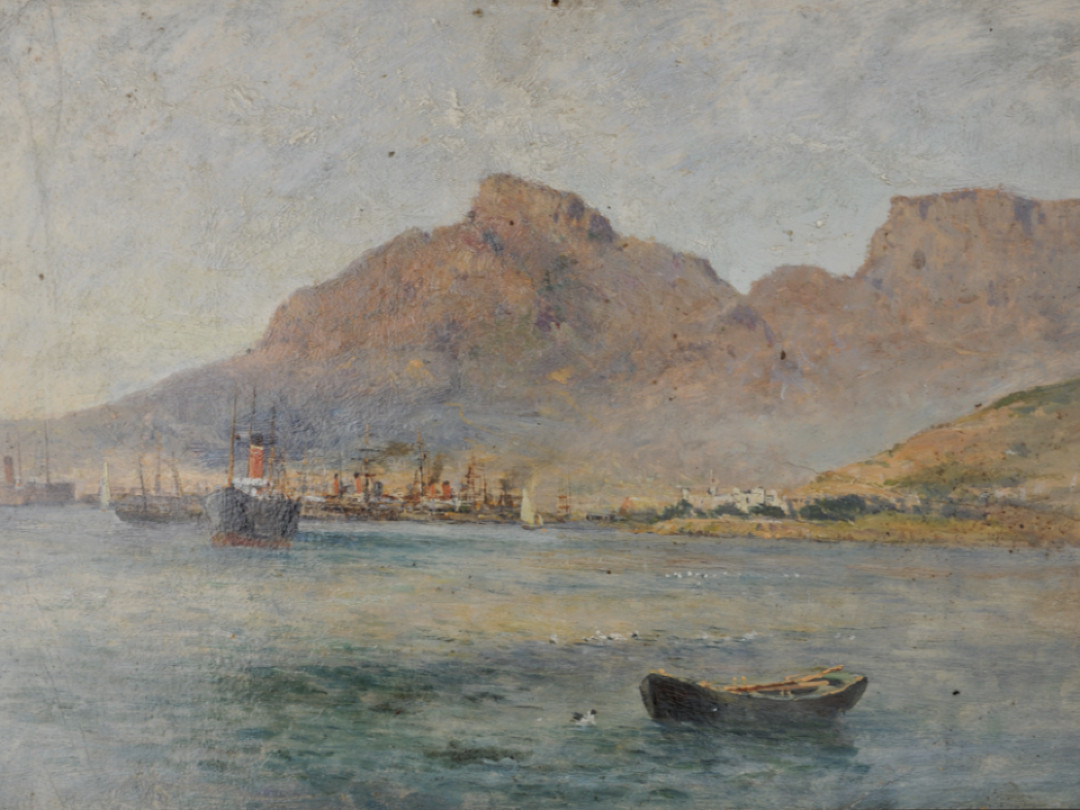
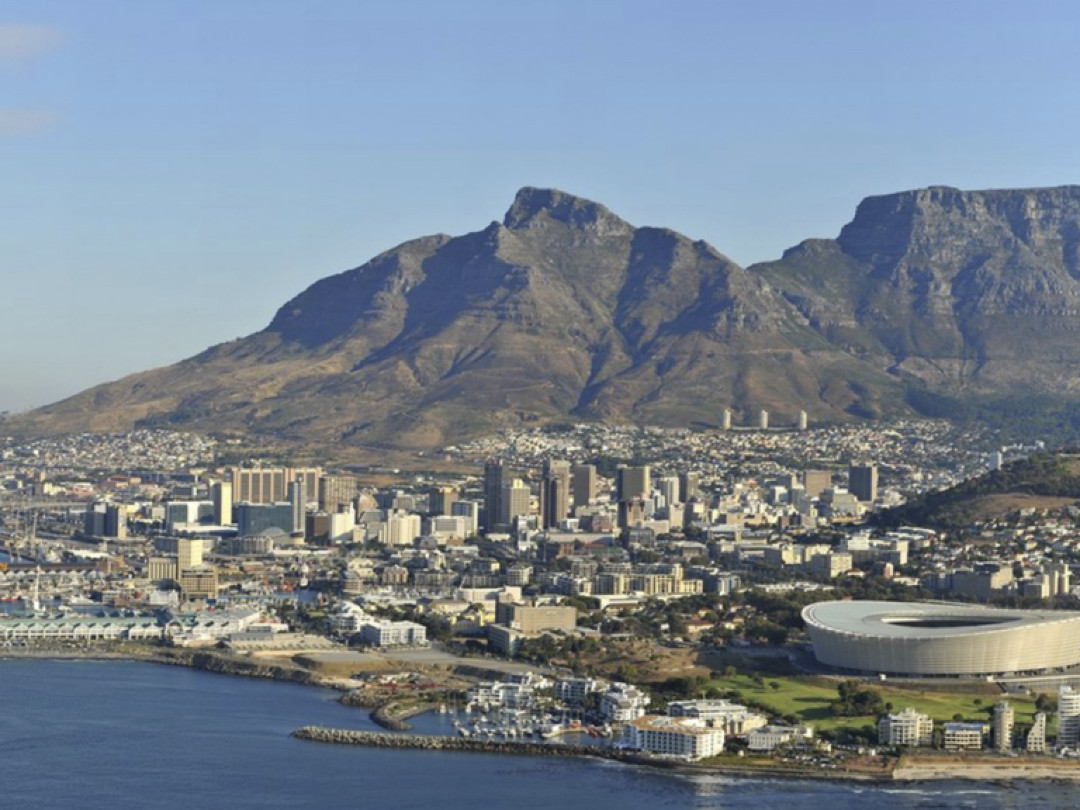
In Penny’s pile of old cardboard were several almost-finished oils of French market scenes dating from a visit to Brittany in 1923. There is a family story that Ernest was once painting a Breton woman sitting outside her cottage, spinning; invited inside, he discovered that her few possessions included a print of one of his own pictures, which hung on the otherwise bare walls.
We’d often wondered where these very French scenes might be, and what they might be like now. Then in 2005 my ensemble Red Byrd was booked for a concert in Poitiers, so Penny and I decided to drive down and stop off in Brittany on the way. We took copies of Ernest’s sketches with us, hoping to track down the places painted 82 years before, and photograph each one from the same spot. It turned out to be an extraordinary trip.
Intriguingly, with the collection of Ernest’s paintings there was a small notebook in which her father Peter, his talent already obvious at the age of 12, had made drawings of his own.
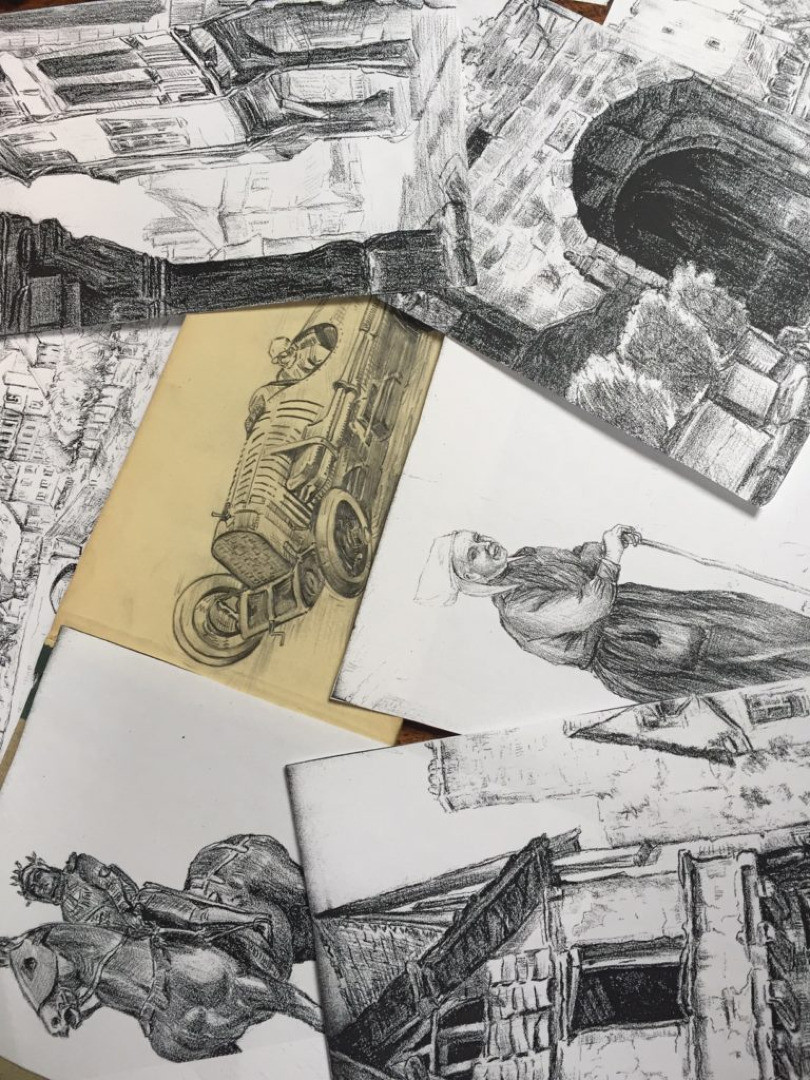
There are detailed drawings of trains and cars as you’d expect from a young boy, but also some portraits and several pictures that looked like same viewsErnest had painted on the same trip. For Peter and his two brothers it must have been an idyllic time, painting and fishing for the long summer months while their father faithfully recorded the Breton countryside and its inhabitants.
None of the oil sketches can have taken longer than a day to produce so the holiday perhaps yielded around a hundred roughs to be taken home for further work. Of the 12 that came down to us only one appears to be finished, but four of them have names scribbled in pencil on the back.
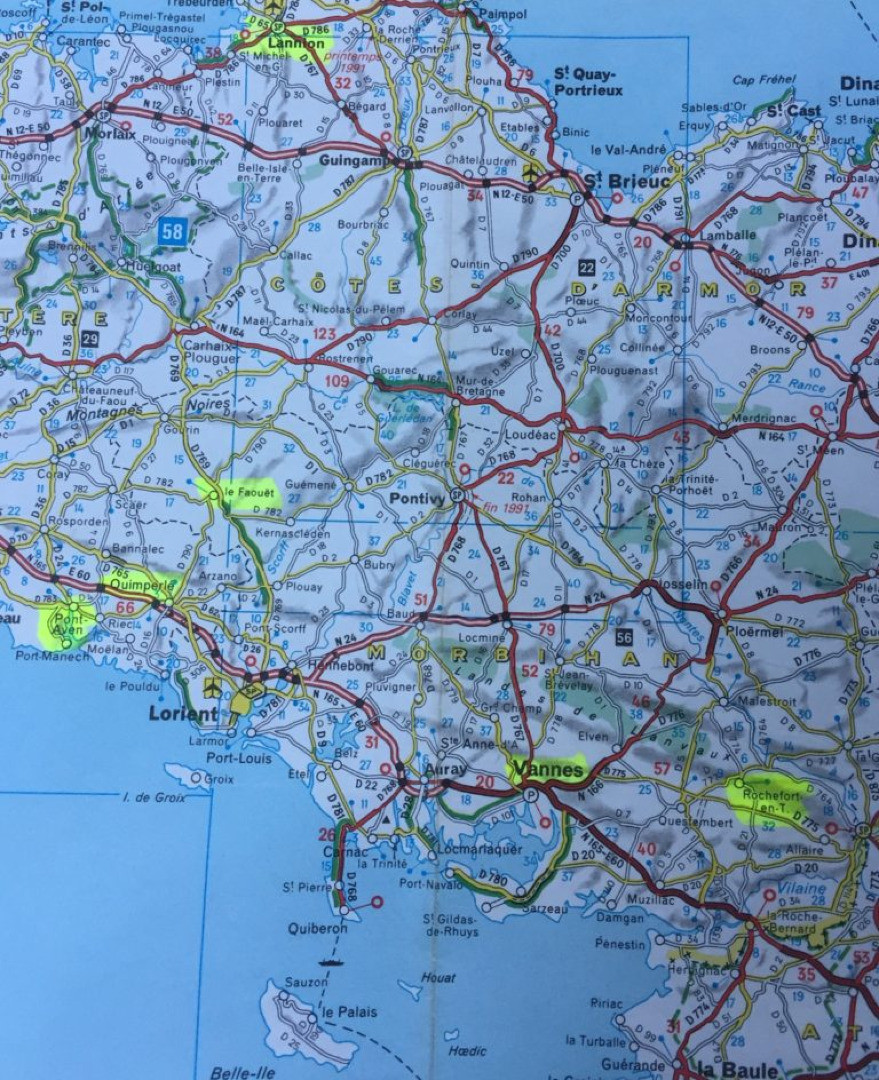
One of the paintings is of the interior of a church, and on the back Peter had written two names: Le Faouët and St Fiacre. We assumed that he couldn’t remember which of these it might be so had written both. Two townscapes were identified as Pont-Aven and Rochefort-en-Terre and there was a rather anonymous field marked Lannion on the back. The one signed picture is of a busy timber framed covered market with vegetable stalls and other products spilling out of it, and several others depict what might be the same market. We had no idea where any of these might be until we looked up St Fiacre on the web and read that it had a famous chapel with a unique carved rood screen and was close to Le Faouët which had an extraordinary 16th century covered market. There was no screen in our church picture but the market hall sounded promising.
We didn’t have much to go on but we set off very optimistically for Rochefort-en-Terre, which we thought might lead us to the sites of at least two of Ernest’s paintings and several of Peter’s drawings. It turned out to be a beautiful village, absolutely unspoiled and surely very like it was all those years ago, but there was nothing remotely like our Ernest views and we drew a complete blank. The one hotel was full so we tried nearby Vannes, which had a large square with a mounted knight in it a bit like one of Peter’s sketches but all their hotels were full too, and the knight’s arm was in the wrong place. We eventually found somewhere to stay on the way to Pont-Aven, our next hope. This little town is also much as it must have been and here we had our first success. After thinking that Peter must have got it wrong about this town as well, Penny realised that we were looking at a bridge in one of the unidentified paintings. We even managed to photograph it with a heavy lorry approaching the same turning as a large covered wagon in the painting.
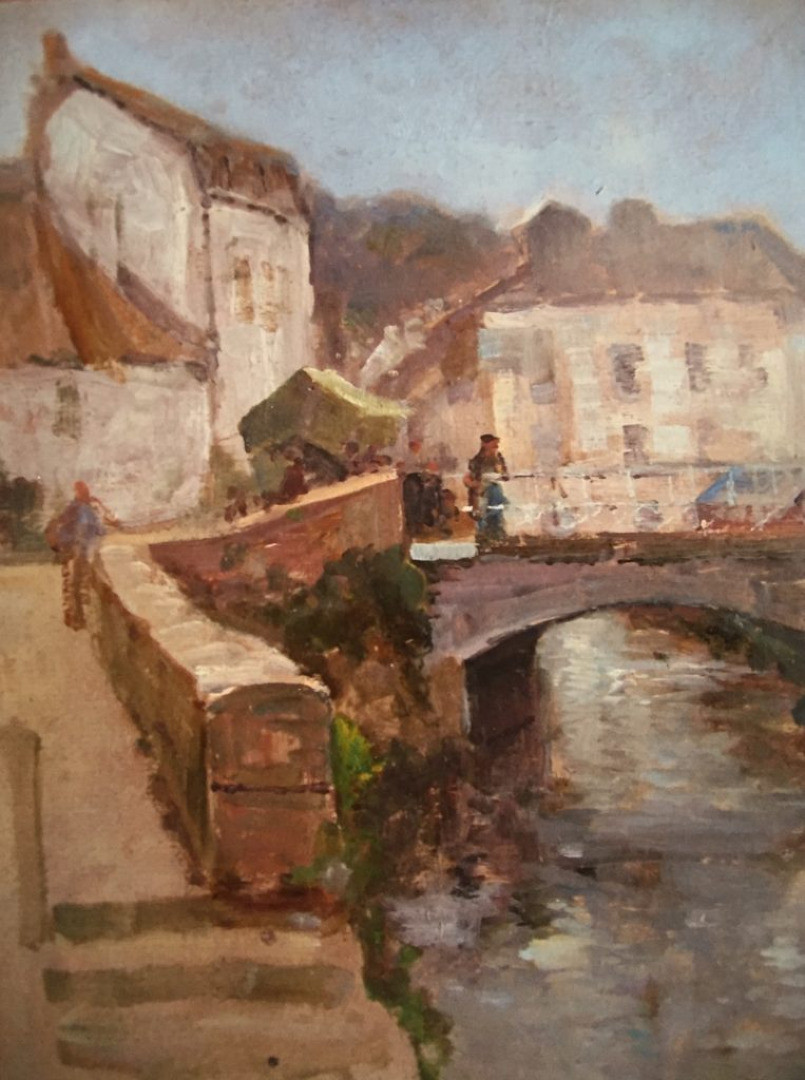
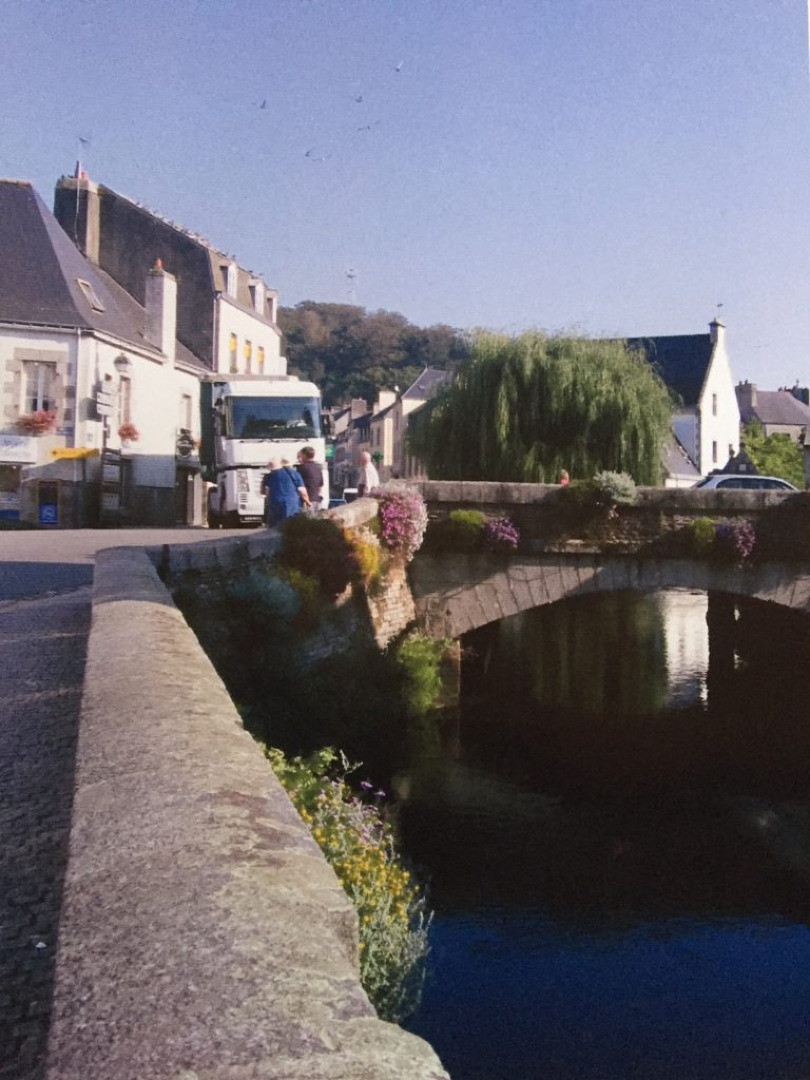
Buoyed up by all this we drove on to St Fiacre in a state of great excitement. The chapel is famous for its unique painted wooden screen dating from 1450 and featuring the seven deadly sins in minute and colourful detail.
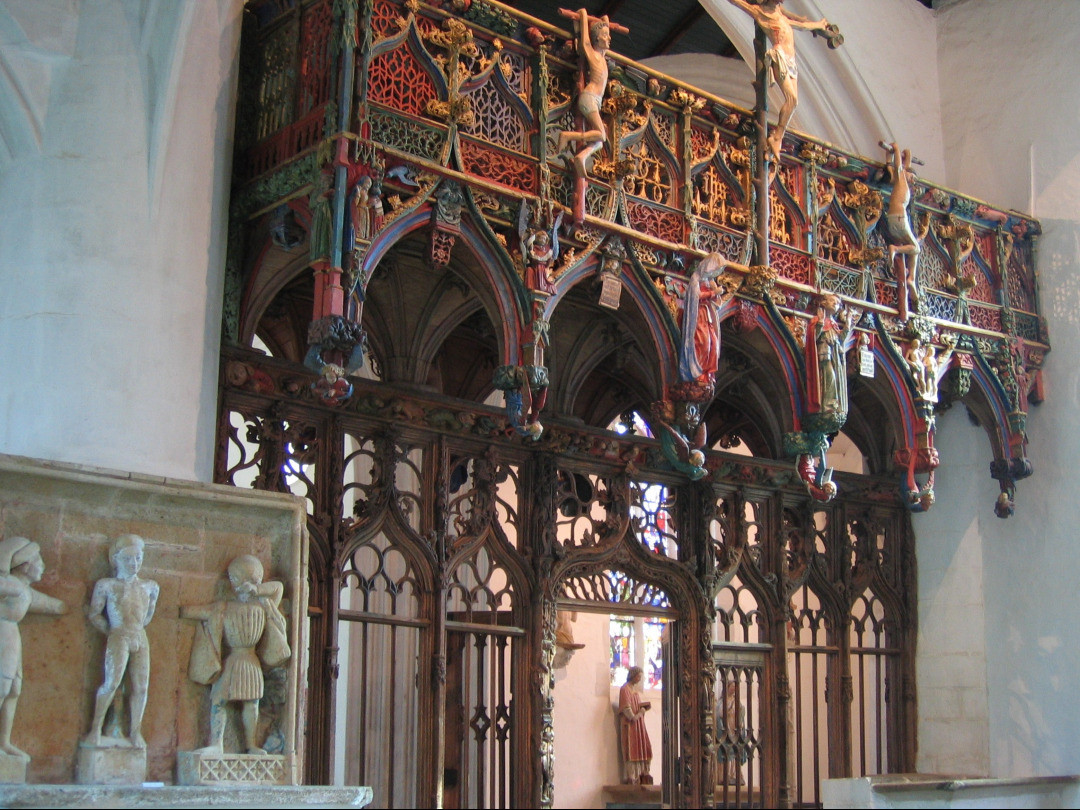
There was nothing like that in our picture, which is a very impressionistic sketch of something vaguely church-like and largely covered in green mould. You can’t miss the riotously exuberant screen as you enter the cold stone of the chapel, but Ernest had ignored it and for some reason ghosted an outline of a side isle. Or perhaps there’s a wonderfully detailed painting of the screen that he actually finished out there somewhere.
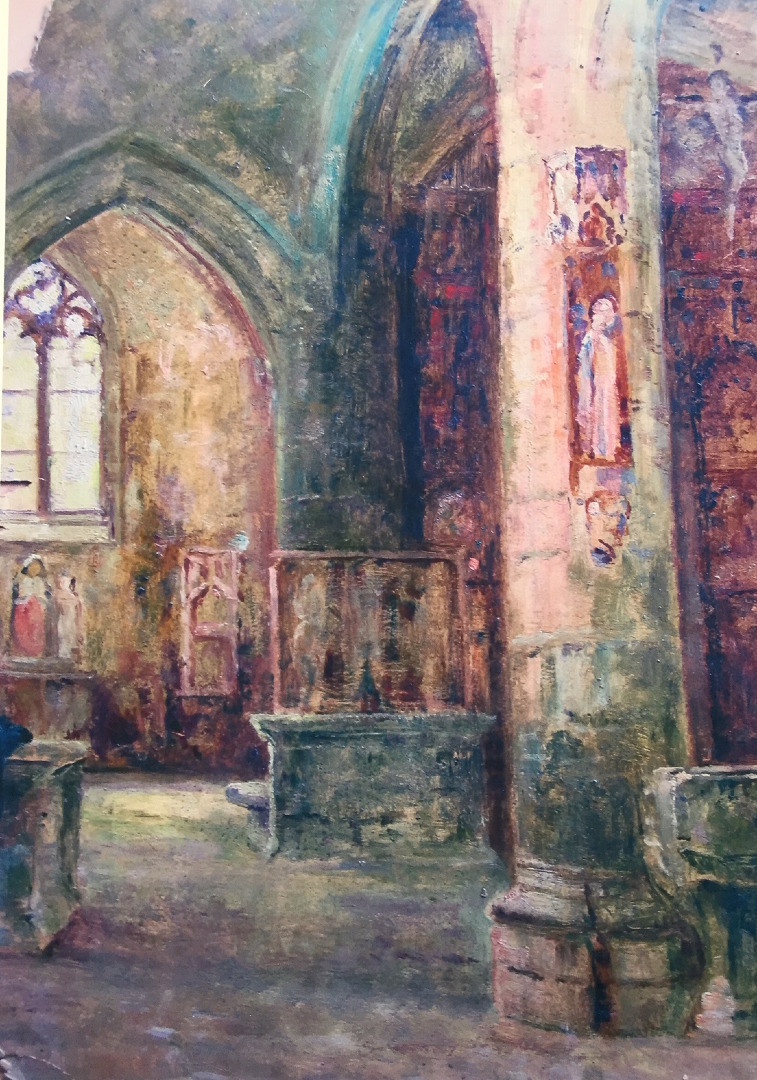

The view was almost identical, and although the walls were now pristine the floor showed unmistakable signs of green mould still growing between the slabs. By now we were getting quite emotional, having stood several times in the same places and recorded the same views as Penny’s grandfather eight decades ago.
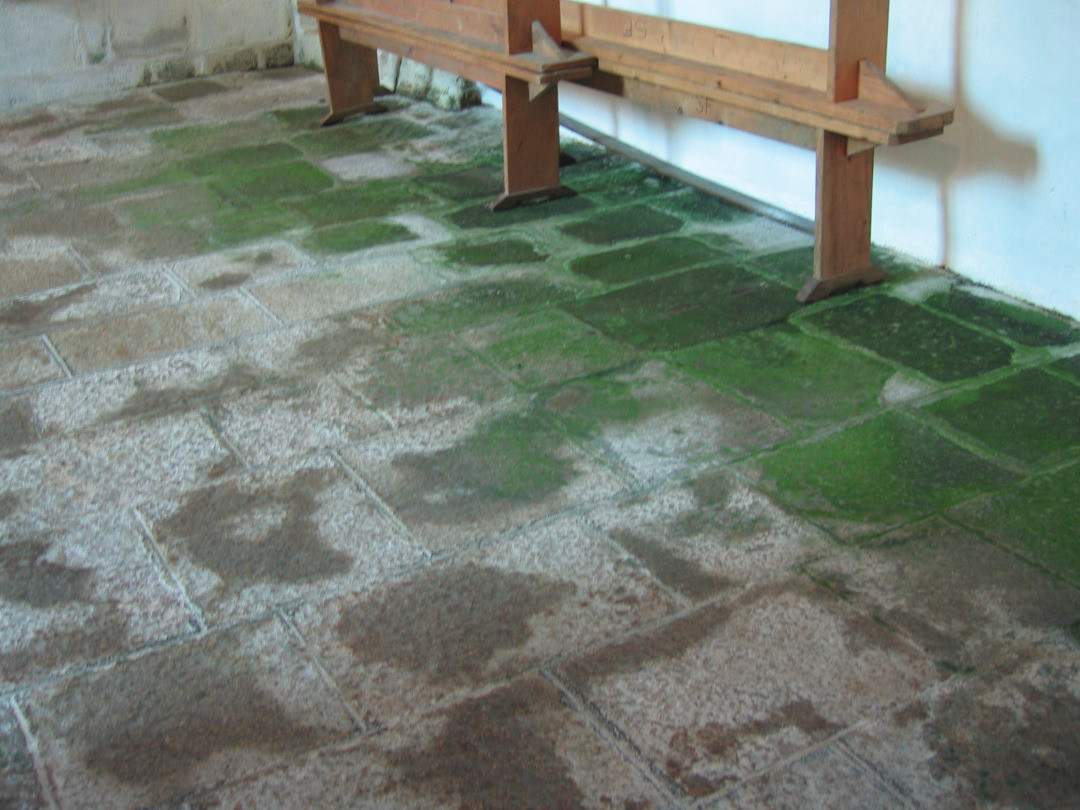
We drove on to Quimperlé, which the map showed had a suitable river which might match one of the unidentified views and desperately tried to make it fit the sketches. The river was just right, complete with an avenue of trees on each side and a church in the background, and there were some lovely half timbered houses in the town.

Nothing quite matched up though, however much we tried to make things fit. We tried to persuade each other that this or that building must have been demolished or rebuilt, and even the local residents we asked thought that Quimperlé must be the place in the picture. Another puzzling feature of these paintings was that the view from one side of the bridge seemed to be autumnal, whereas we knew that Ernest had only been there in the summer. Nevertheless, we had high hopes of Le Faouët’s market hall, and the next day went to have a look.
We drove on to La Faouët and were amazed to come across a huge timber-framed market hall very like the one in several of the pictures which Penny’s father Peter Walbourn had labelled Rochefort-en-Terre.
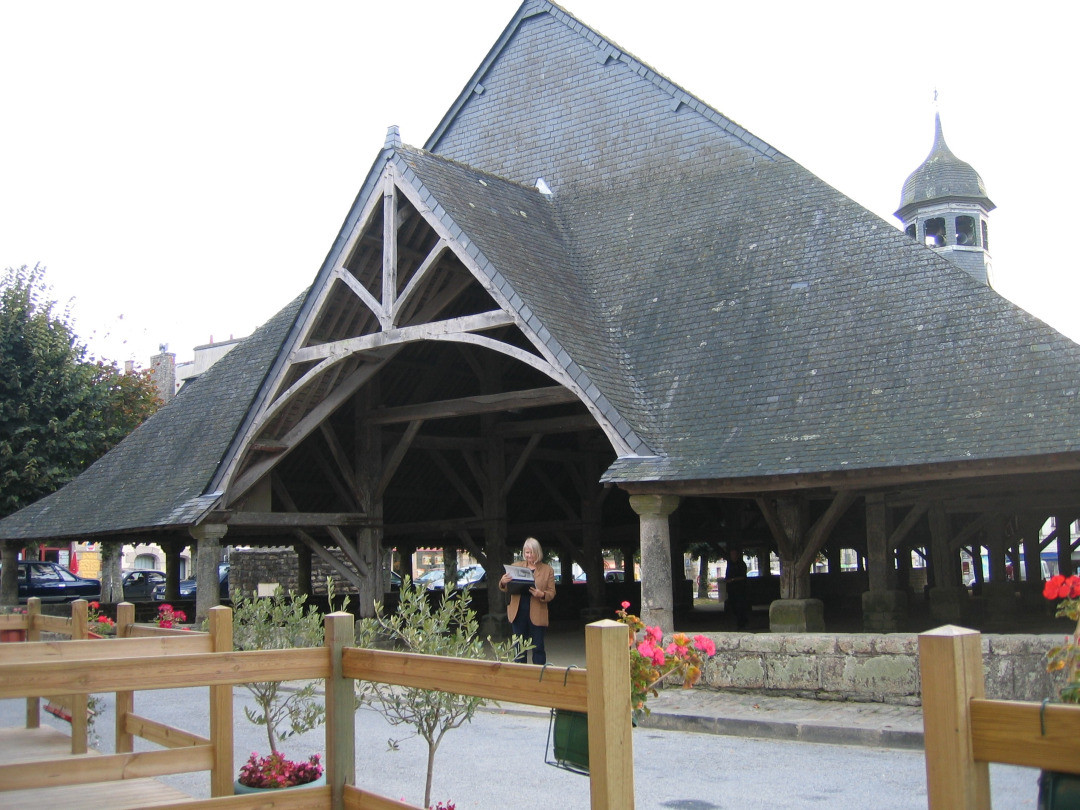

It’s another lovely old town, slightly scruffy and also associated with artists of the twenties and thirties. Many had painted similar scenes to ours, mostly of peasants at market. We scoured the town for matching views. Penny had already worked out that parts of what seemed to be the same building appeared in two of the photos tucked into the 12 year old Peter’s sketch book. These showed market stalls and traders apparently in the street; we quickly realised that these were taken from the far end of the market hall, and apart from the rather busy road not much had changed.
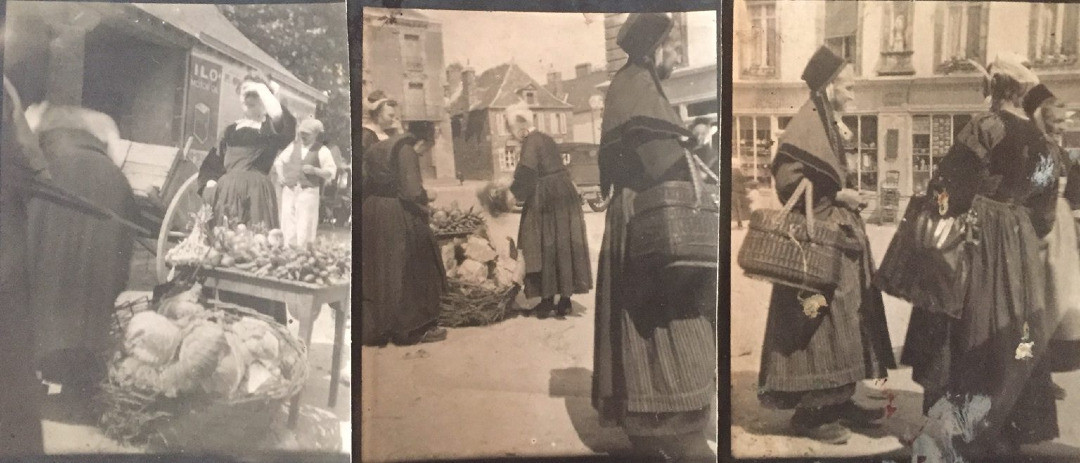
By mid-morning the market was teeming with people, just as it had been when Ernest painted the stalls in 1923.
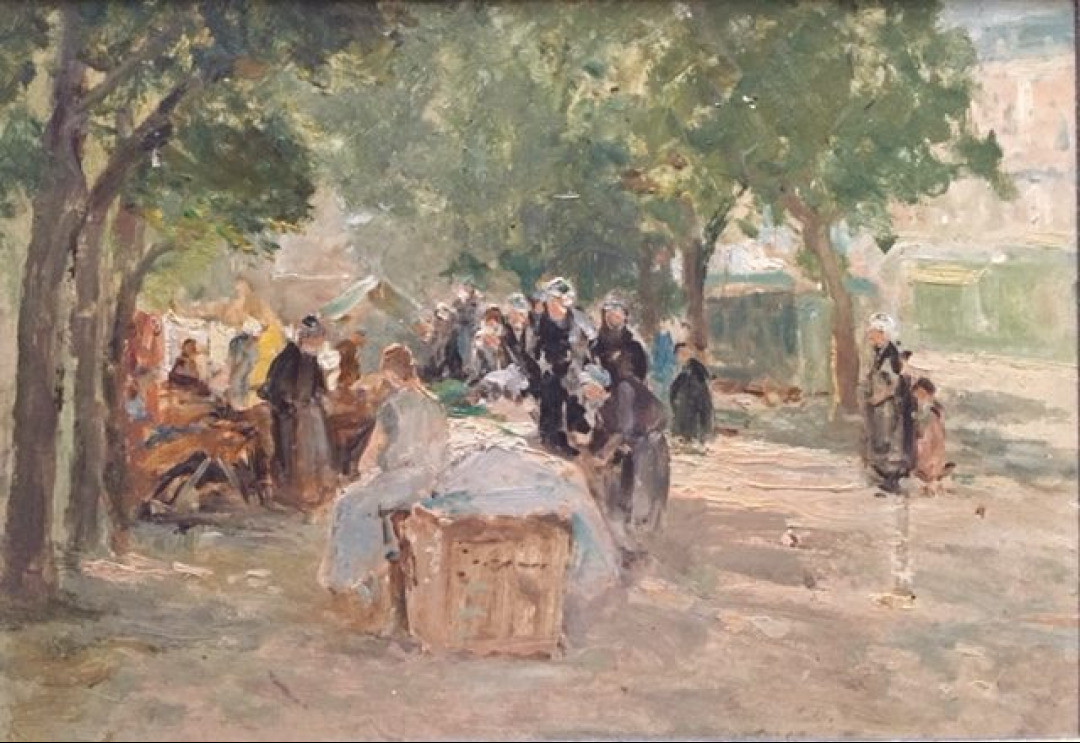
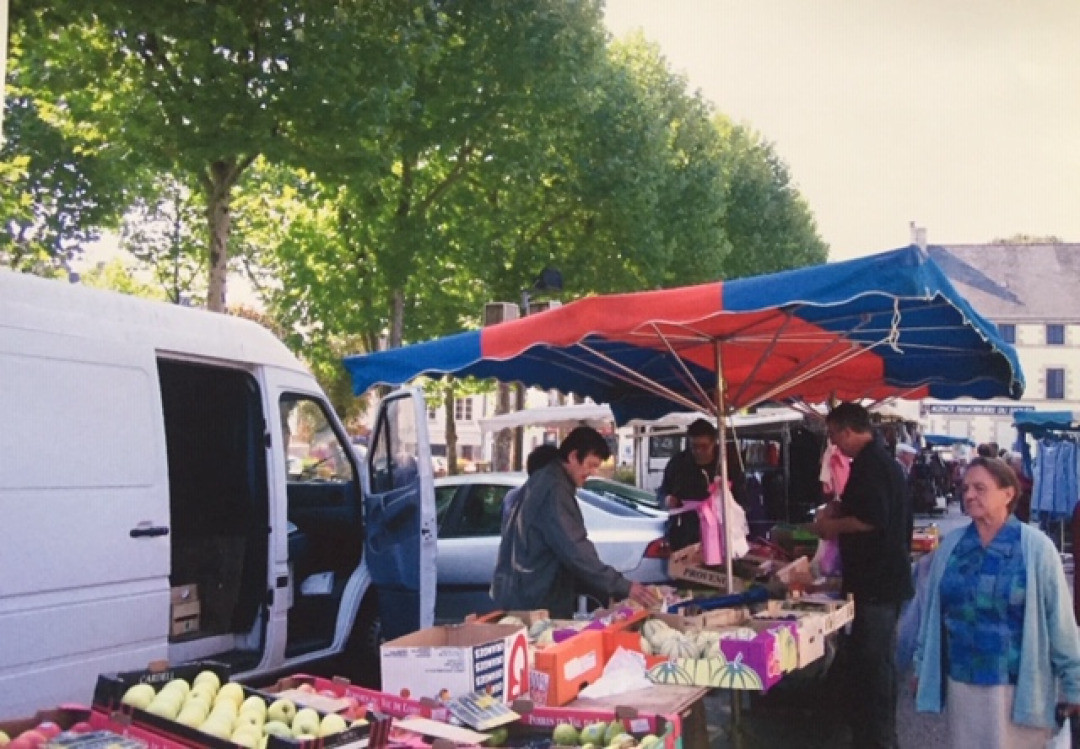
We subsequently discovered that the market is only held twice a month, so we were very lucky to walk straight into a modern equivalent of the scenes in the paintings.
We also located the site of Ernest’s charming side view of the hall, which was now graced with a pissoir in the foreground.

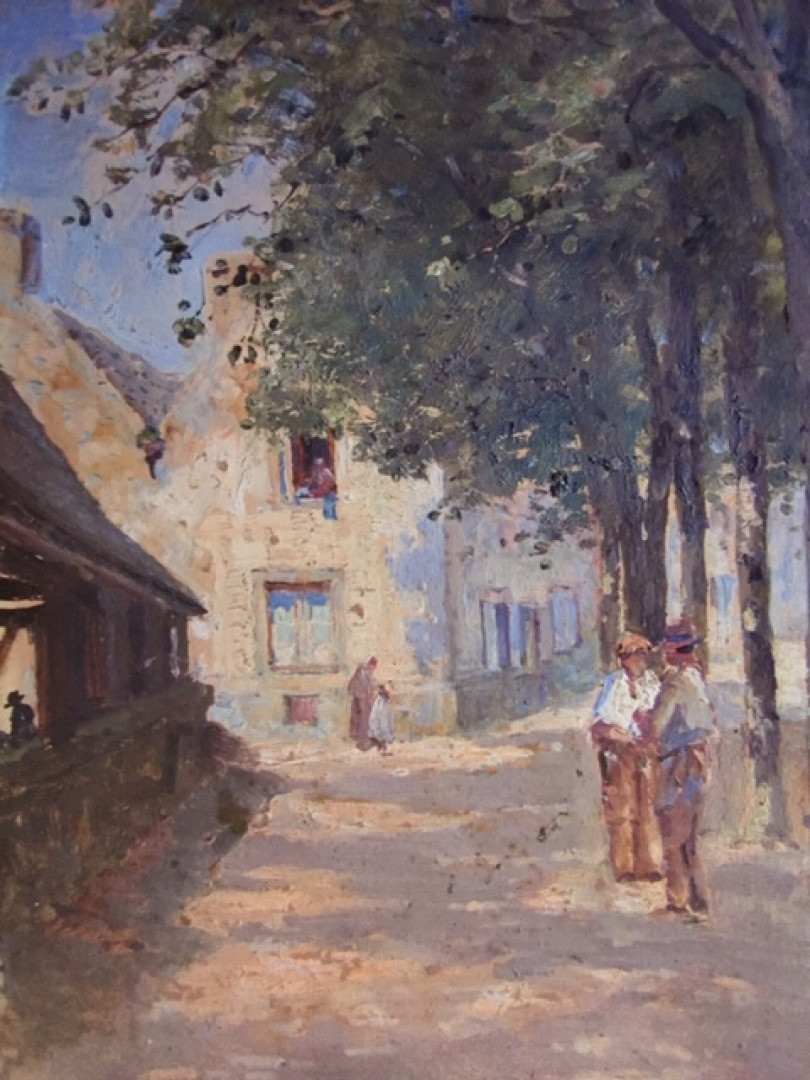
We couldn’t make all the Rochefort pictures fit La Faouët. We spent ages failing to find a Breton house with a well in front of it and went to bed exhausted but still very pleased with ourselves.
The next day we visited the Musée du Faouët, to find many pictures of the town painted by French, British and American artists of the 20s and 30s. One of them, Le Jour des Pauvres , painted in 1920 by Germaine David-Nillet showed the same view of the market square also with knots of people standing around apparently waiting for something. The museum assistant told us that in the late summer there used to be a day set aside for almsgiving: both David-Nillet and Ernest Walbourn had captured the same scene on the same day three years apart.

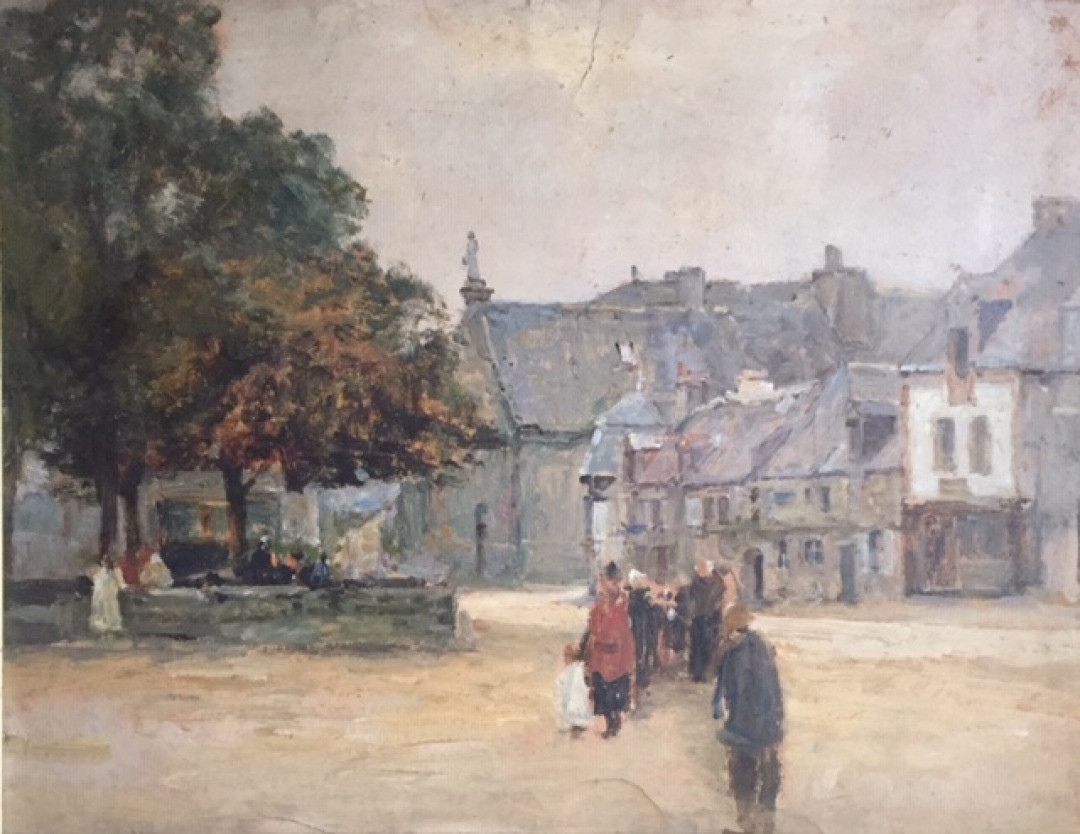
The discovery of the chapel in St Fiacre and the market hall in Le Faouët was incredibly exciting. We had two days left before we had to leave for my gig in Avignon, and several pictures still to identify. Clor inspection of Peter’s sketch of a river with the squat tower suggested that the river was probably tidal. The only other name we had was Lannion, scribbled on the back of a field that could have been anywhere, but it is on the coast and the map showed a river running through it. It was all we had to go on, so we crossed our fingers and set off north to have a look. As soon as we crossed the brow of the hill outside the town we recognised the two church towers, one a slim spire and other unmistakably flat-topped. As we got closer we could see the river, with the trees miraculously the same size as in the painting from 82 years before.
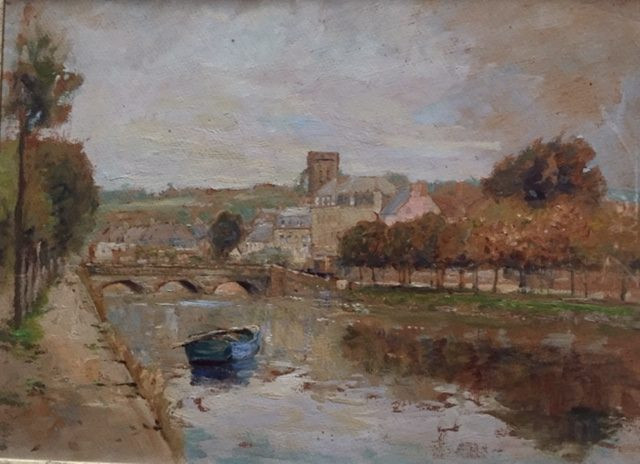
Peter also sketched the same view:

We were also able to solve the autumn tree riddle. We knew they were there in the summer but the trees on one side of the river seemed autumnal. We could now see that the right bank was planted with horse chestnuts, which lose their leaves much earlier than the plane trees on the other side; and by coincidence we had arrived at a time when the next generation of replanted avenues exactly matched those in the picture.
Closer still, we found that the tide was out and there were stakes for a kayak slalom course, but we managed to find Ernest’s downstream view:
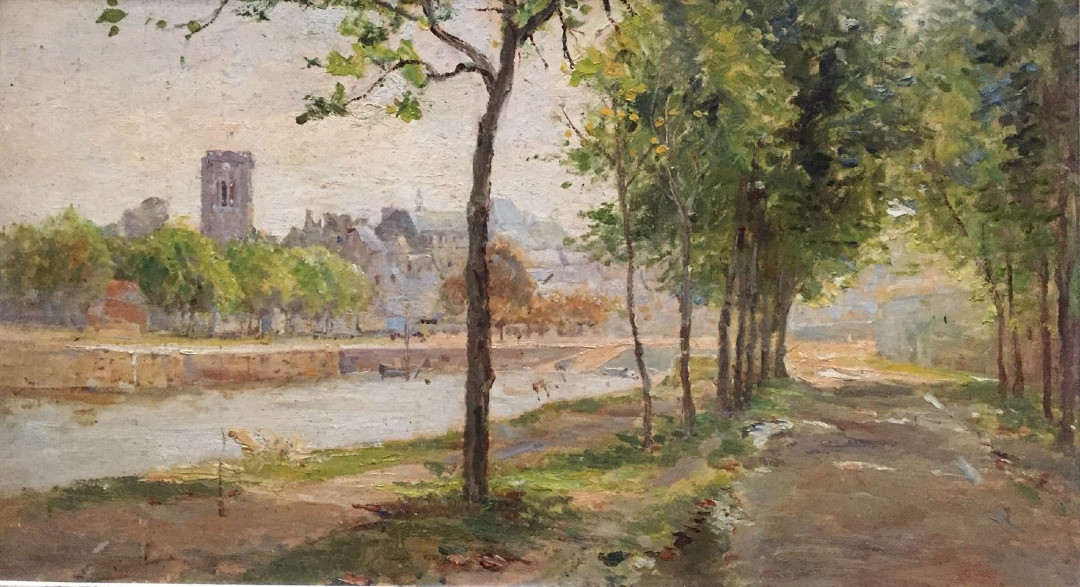
at some risk, as Ernest had obviously set up his easel in the middle of the road, and the original trees were grown so huge we had to resort to a bit of trick photography:
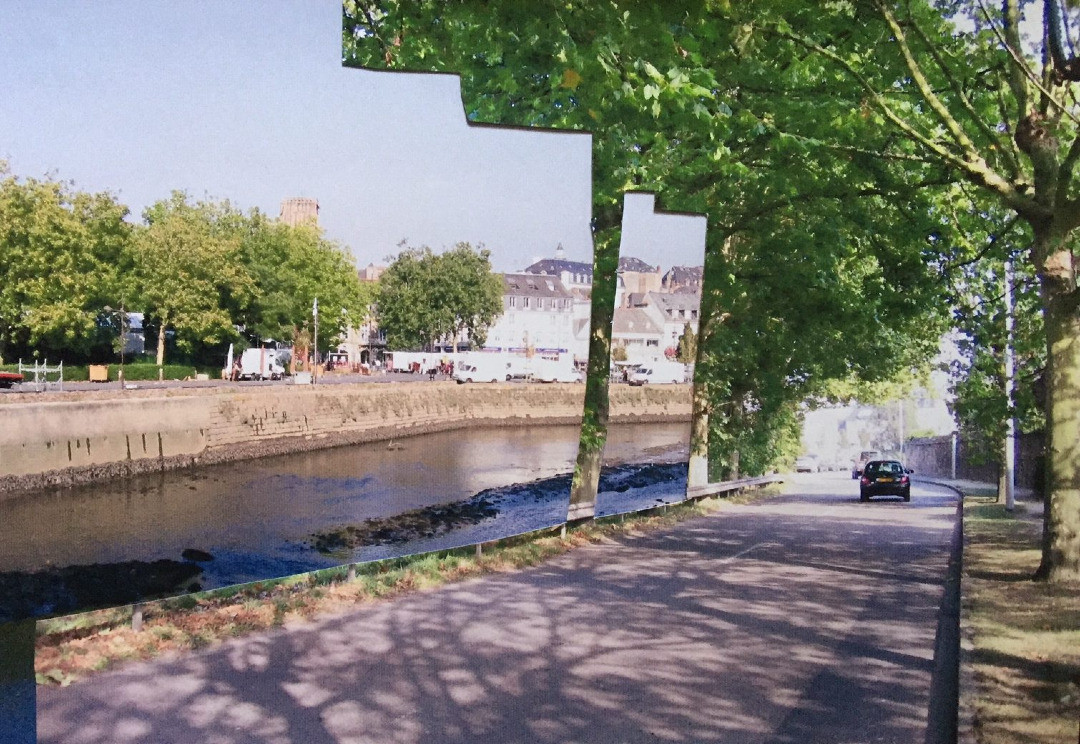
The family must have spent some time in Lannion as there are several sketches by Peter, his eye pretty amazing for a 12 year old:
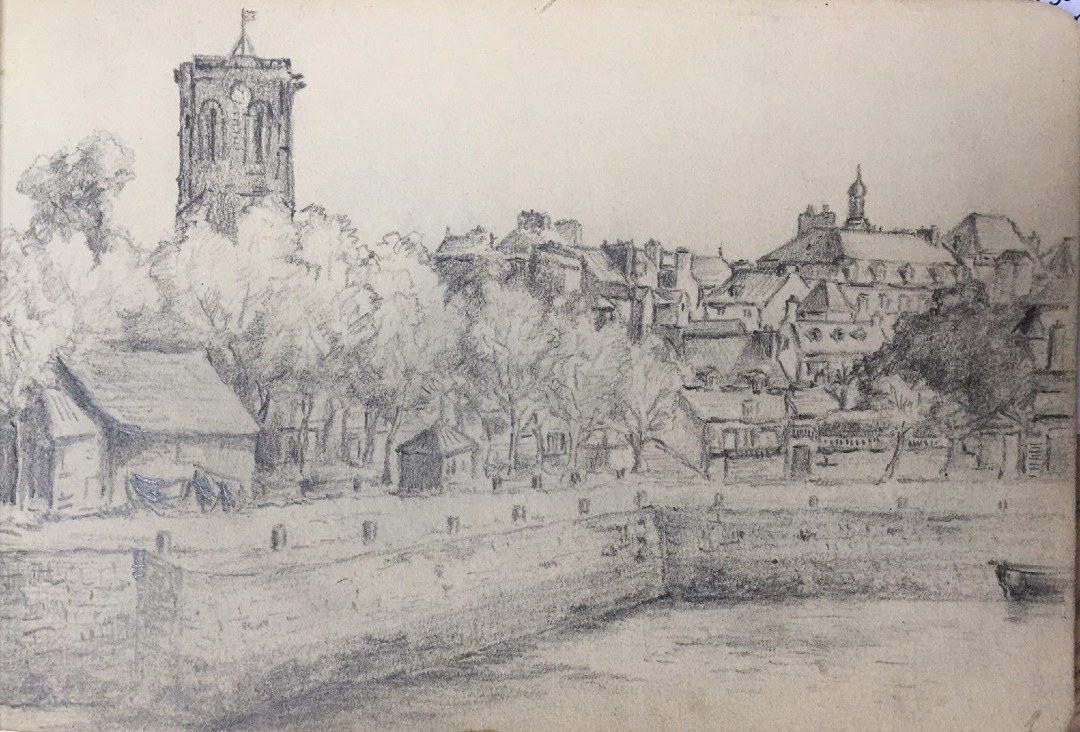
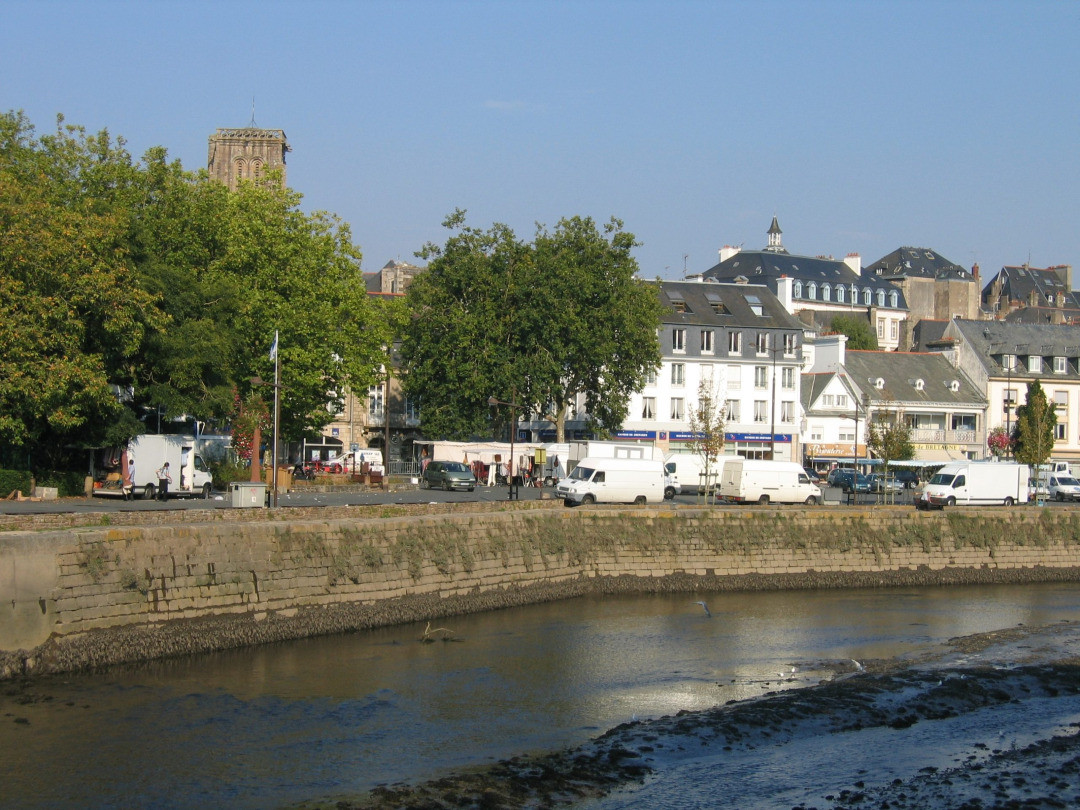
We climbed the hill which Peter had sketched, looking for where he’d painted the church. There’s probably an Ernest of the same view out there somewhere.
After a lot of speculative position changing we finally found the exact place where he had been standing (like many of his father’s, in the middle of the road).
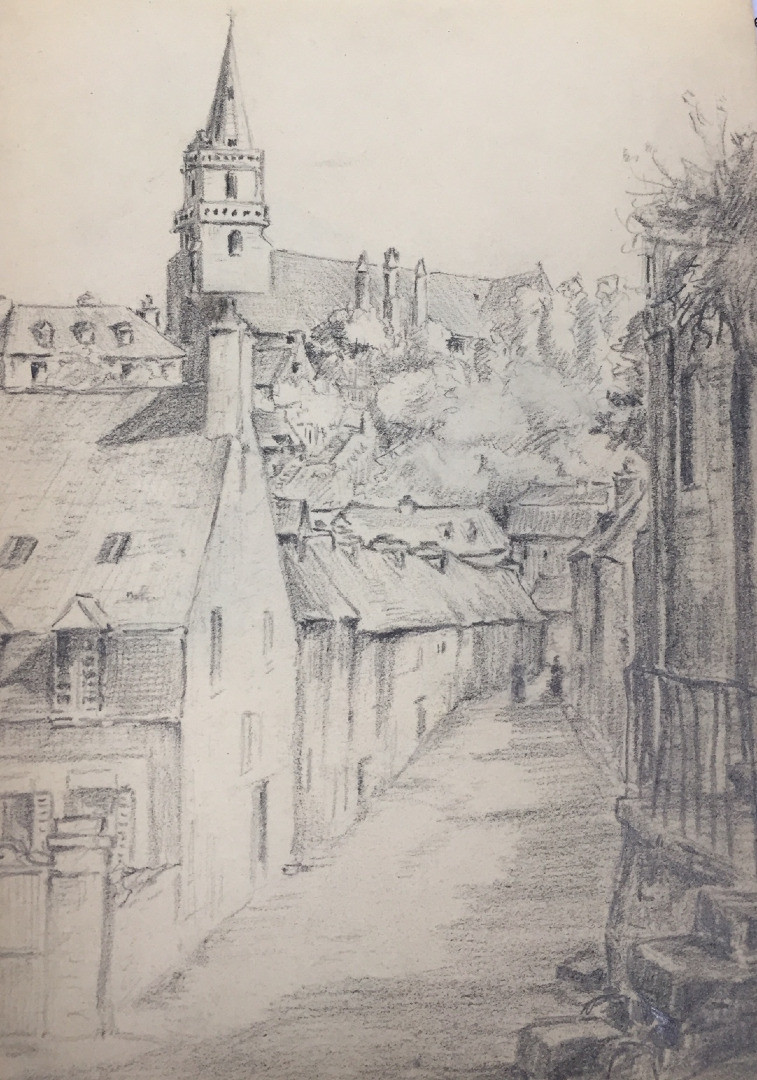
The old stone terraced cottages sadly now a car park:

We tried hard to make Lannion’s half-timbered houses and one grand square fit the sketches but again drew a blank. What of the field with its scribbled ident? That evening we looked again at the map and there was a bend in the river that might well produce the view we wanted, but we had one more day and thought we should have another go at Rochefort-en-Terre.
We’d found almost all of the Walbourn oil sketches that we’d brought with us. We had more photocopies of some of the pencil sketches in 12 year old Peter’s little notebook but none of them seemed to correspond to any of the remaining Ernests. Reflecting on our experiences over the previous two days Penny convinced herself that two or more of the Ernests must be in Rochefort, which Peter had attributed to the Le Faouët paintings and which we had visited but just hadn’t been able to make fit. The next day, our last before setting off for my gig in Avignon, we made the long drive back from Lannion for a closer examination of Rochefort’s market. To our great joy we did indeed find what seemed to be the view: a market square, a grand house and a road sloping away into the distance. We took several pictures before realising that what didn’t quite fit without a lot of excuses (trying to account for missing chimneys, wrong gables and the like). But suddenly everything slotted perfectly into place if we pointed our camera at right-angles: there were all the same ingredients but no compromise was needed – it was clearly the Ernest view, the market long gone.

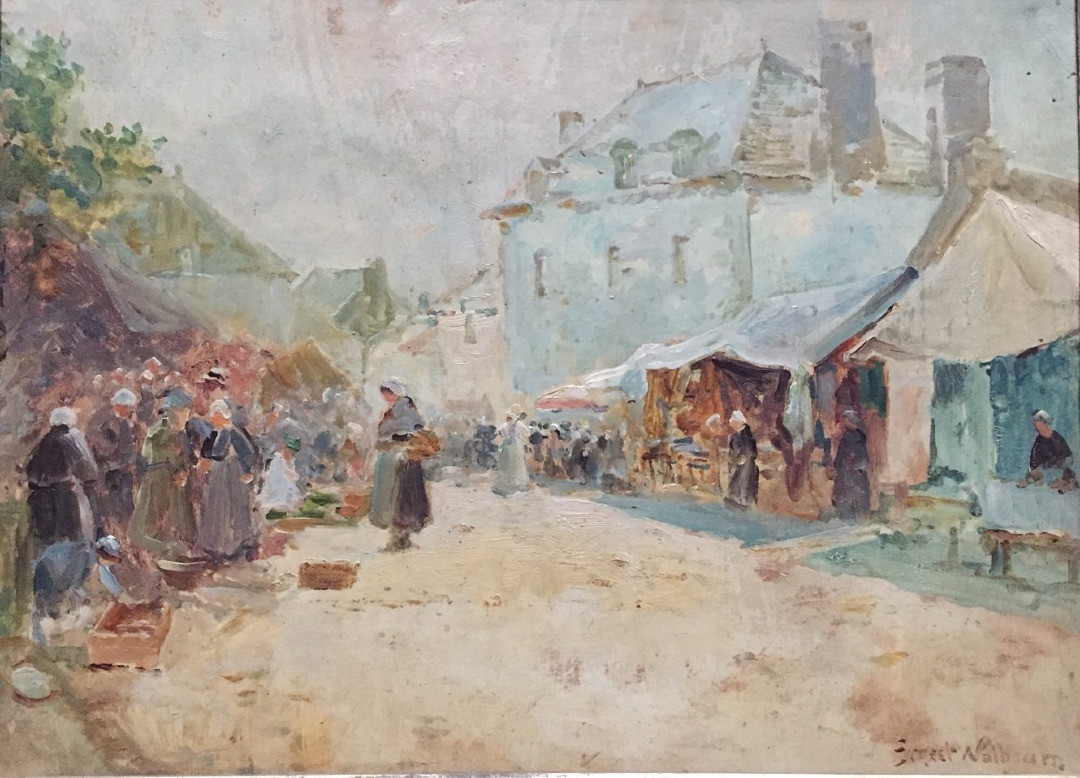
A few streets away the same thing happened with the house with the well. We found what seemed to be the house but the well seemed to have moved.

Again we changed our own perspective and magically the view appeared, almost identical to the painting, but with municipal plant pots for tourists rather than the 1920s local colour.

There was no sign of Peter’s knight on horseback or his and Ernest’s sketches of tightly packed half timbered houses. We’d only brought photocopies of Peter’s book rather than risk losing it, which was a pity because if the drawings were all in the same place they would presumably be consecutive entries in the sketchbook.
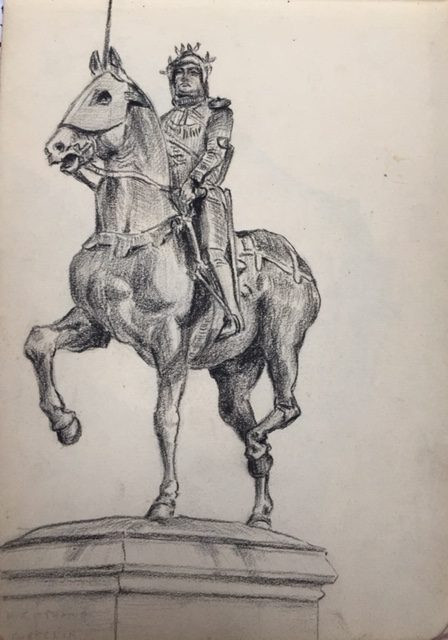
Nevertheless, we’d been very lucky and resolved to come back again having done some more research, and perhaps even find the bend in the river at Lannion.
When we arrived home we found that all of the unidentified sketches by Peter were indeed together in the book. Penny also managed to make out the name on the statue’s plinth.
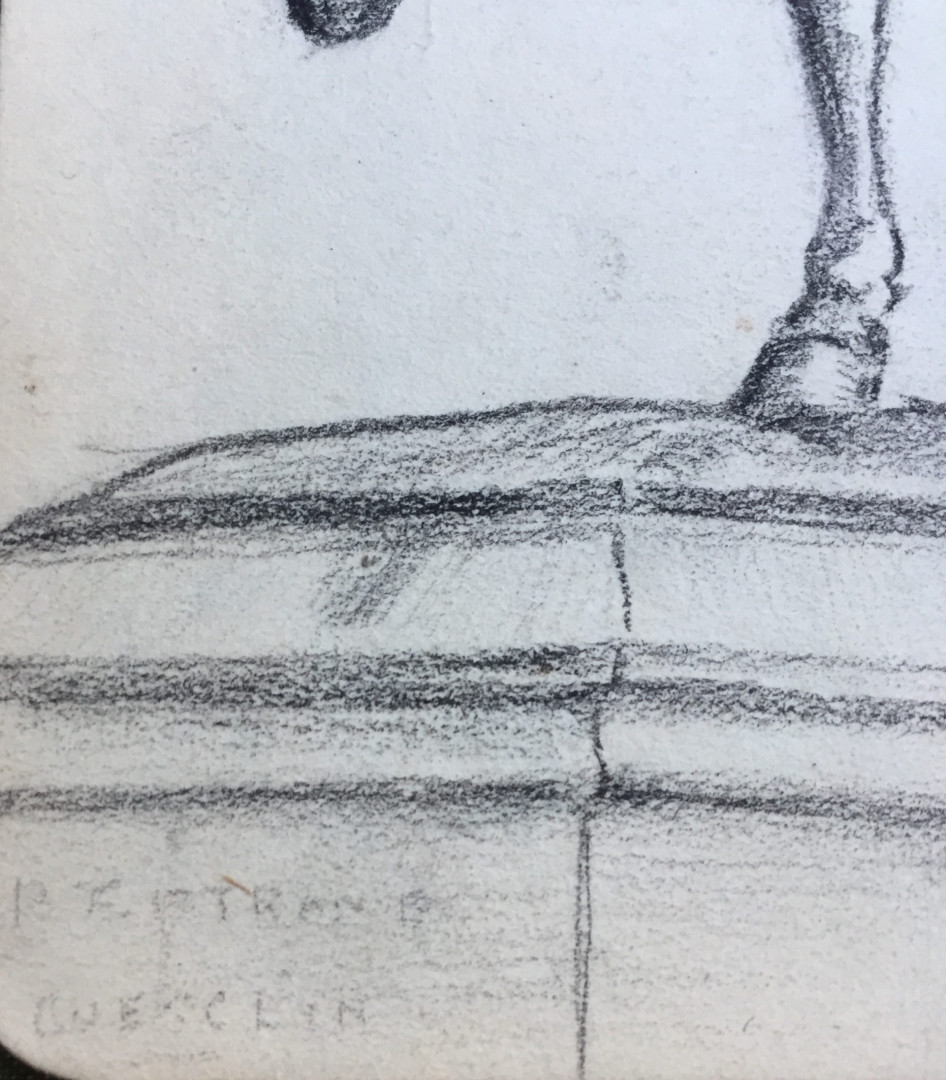
Peter’s pencil is barely visible, but multiple web searches eventually revealed him to be Bertrand Du Guesclin, the 14th century Eagle of Brittany (or the Black Dog of Brocéliande, depending on your point of view) still standing in a square in Dinan. Google also has a modern photograph that must have been taken from the same spot that Peter had used. Dinan has (or had) lots of half-timbered houses, and we resolved that the next year we would go to Dinan, a trip that we still haven’t got around to.
We still haven’t visited Dinan to track down the remaining pictures from 1923 but we do sometimes get out the box of photos from the period. Inevitably, the ones you really want to see have faded back into history. Those that survive still give an impression of a comfortable bourgeois life between the wars – family holidays, boating, tennis parties, gardening, and formal family portraits. There are also shots of Ernest at work, often at the same easel Peter would use long after his death, and on which a large unfinished Ernest is now perched, conveniently hiding our tv. Here is the great man at work:
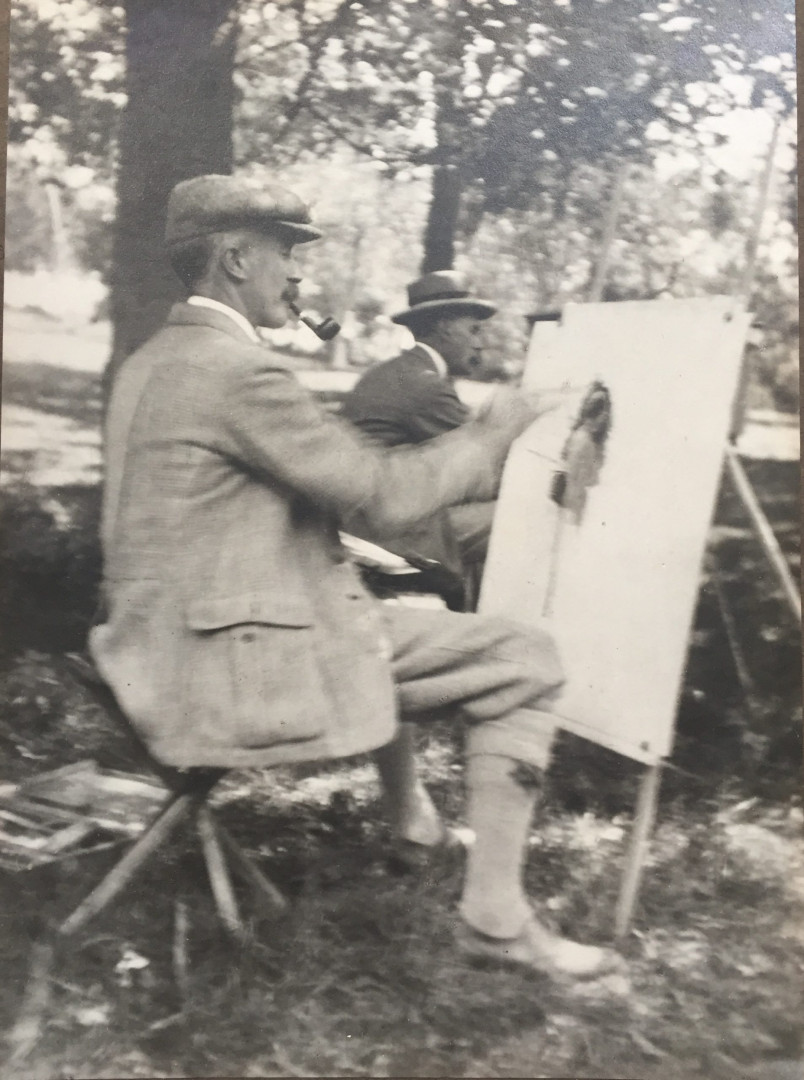
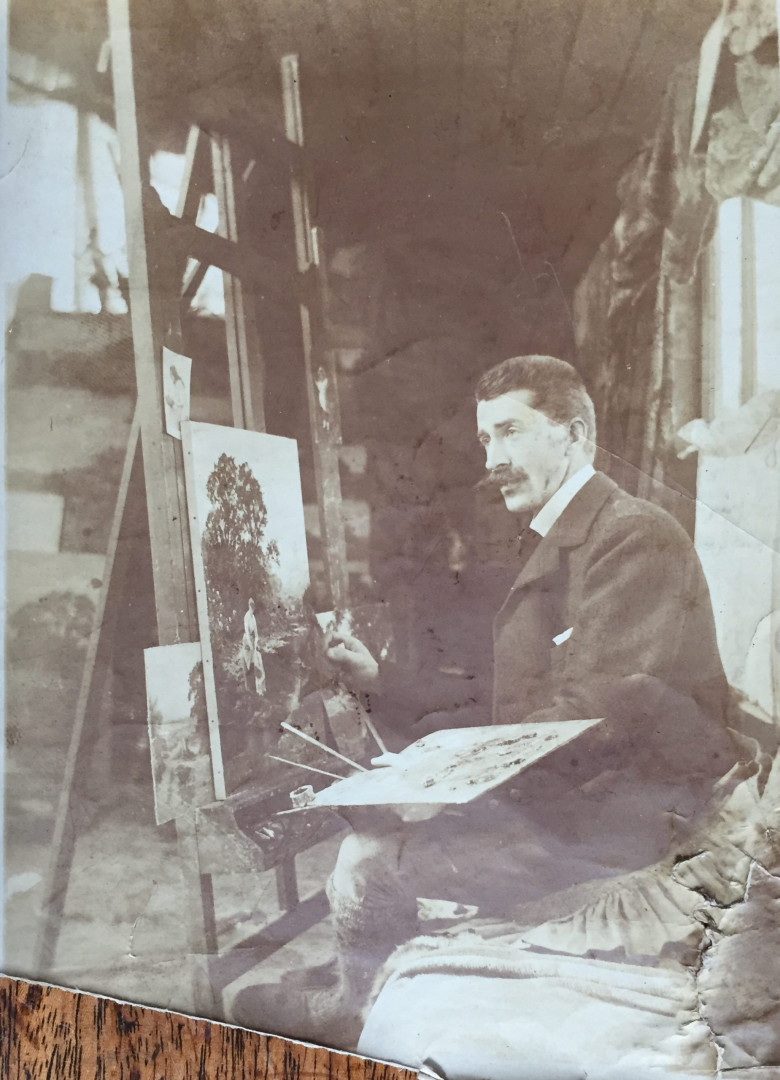
He was also a bit of a sportsman. We have a letter of March 1897 from the captain of a hockey team referring to his prowess as a goal keeper (with the added advantage of being able to sing and play the banjo). He was invited to join the Olympic shooting team; we have a letter from a committee member reassuring colleagues worried about letting in someone familiar with a gun who would rather paint pheasants than shoot them, that even though he was an artist he was a gentleman.
This is Ernest’s wife Eva, a successful artist in her own right, especially as a painter of flowers and gardens, patronised by no less than Queen Mary herself. She sometimes painted Ernest’s backgrounds for him, and the picture on her easel here looks more like one of his.
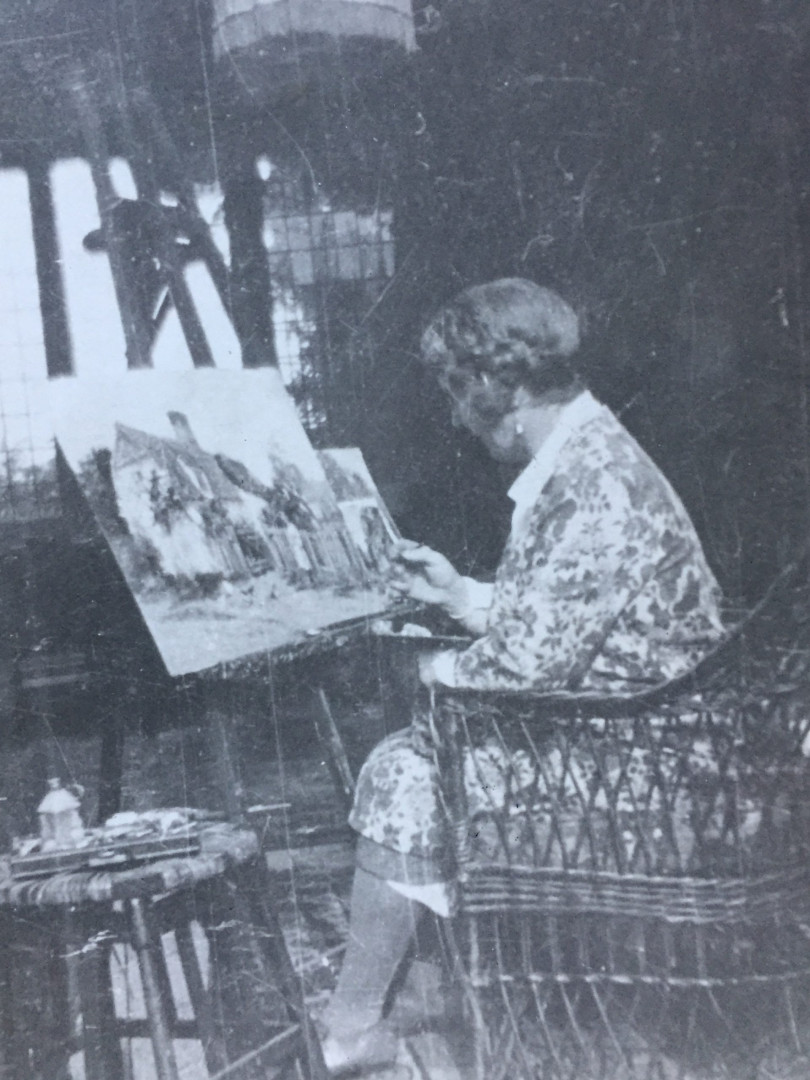
There’s a small family album with pictures of holidays and various sporting activities. There was lots of cricket and golf…

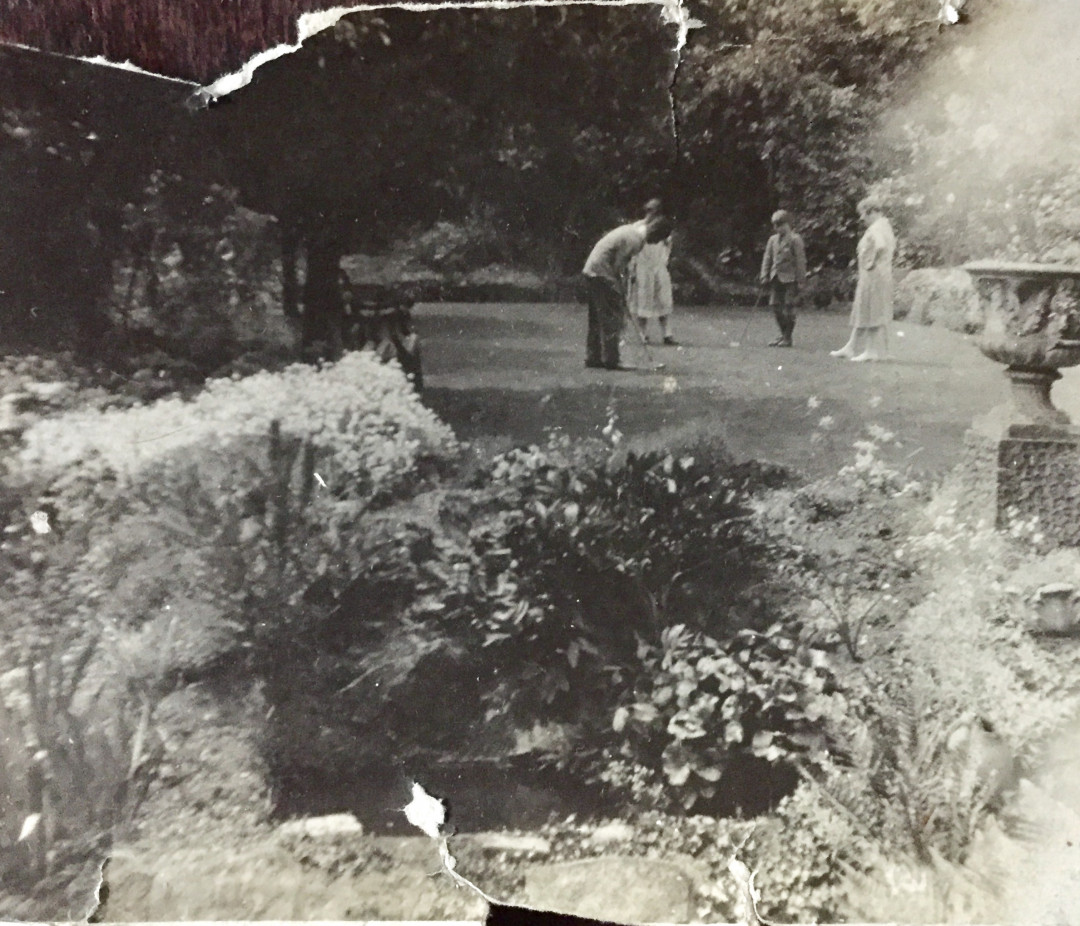
And plenty of tennis…

…and inter-generational amateur dramatics:
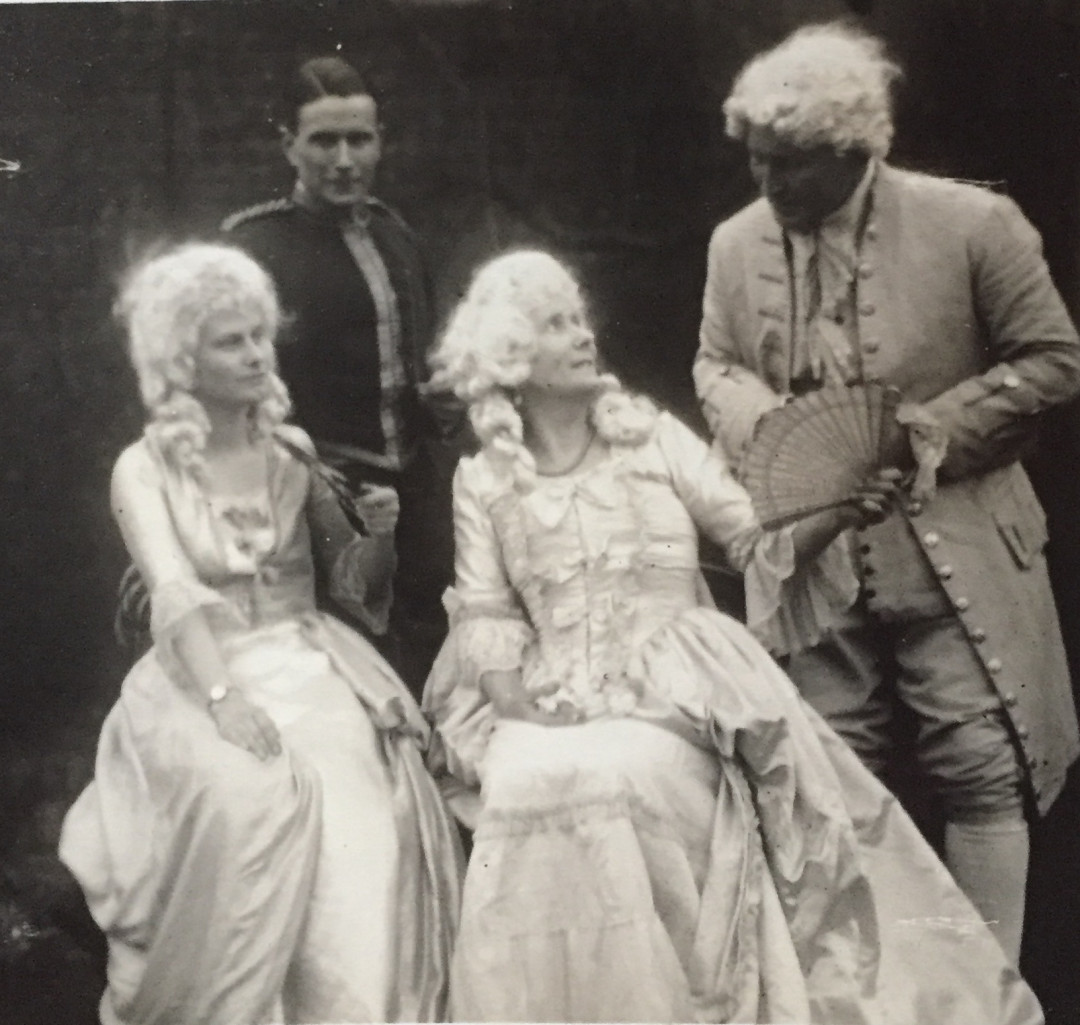
The bottom right snap from the album above is Ernest’s house and studio backing onto Epping Forest. Peter inherited the Victorian statue on the plinth in the foreground and it stood in his garden for many years until it was vandalised, the lady only surviving from the waist upwards. Her remains now rest atop a salvaged piece of York Minster West window in our little courtyard:
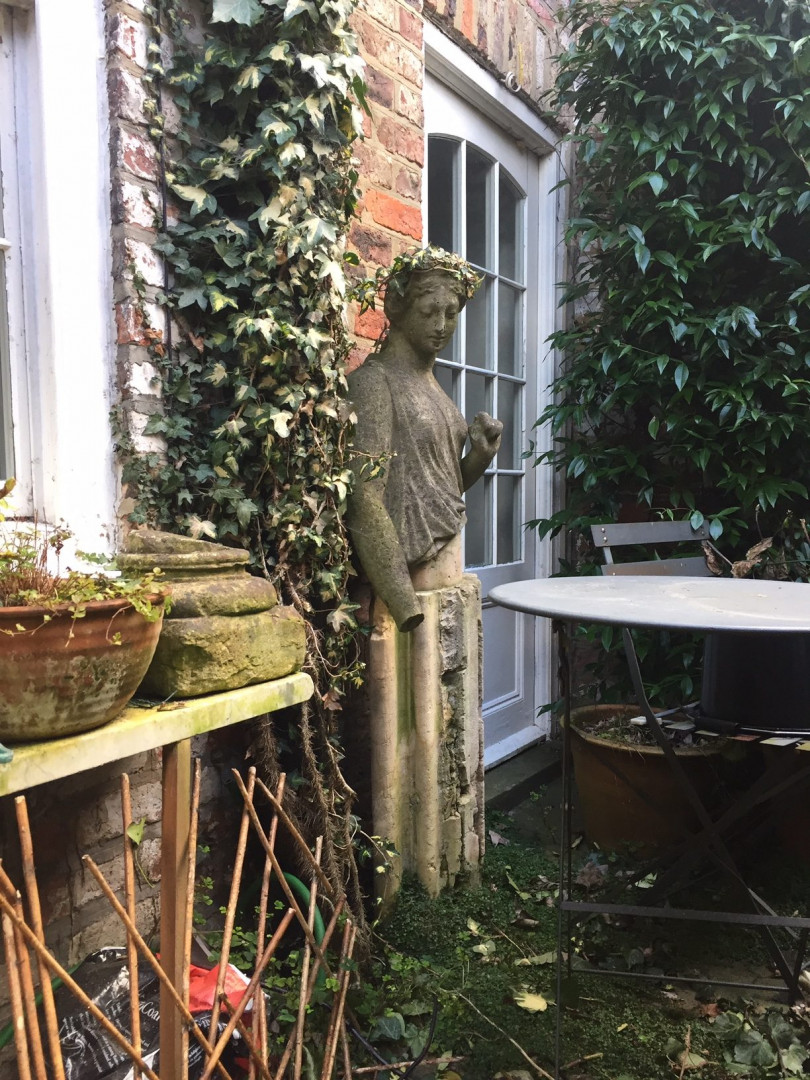
The ornate pot in the shot of the family practicing putting in the garden has followed us from house to house, increasingly battered:
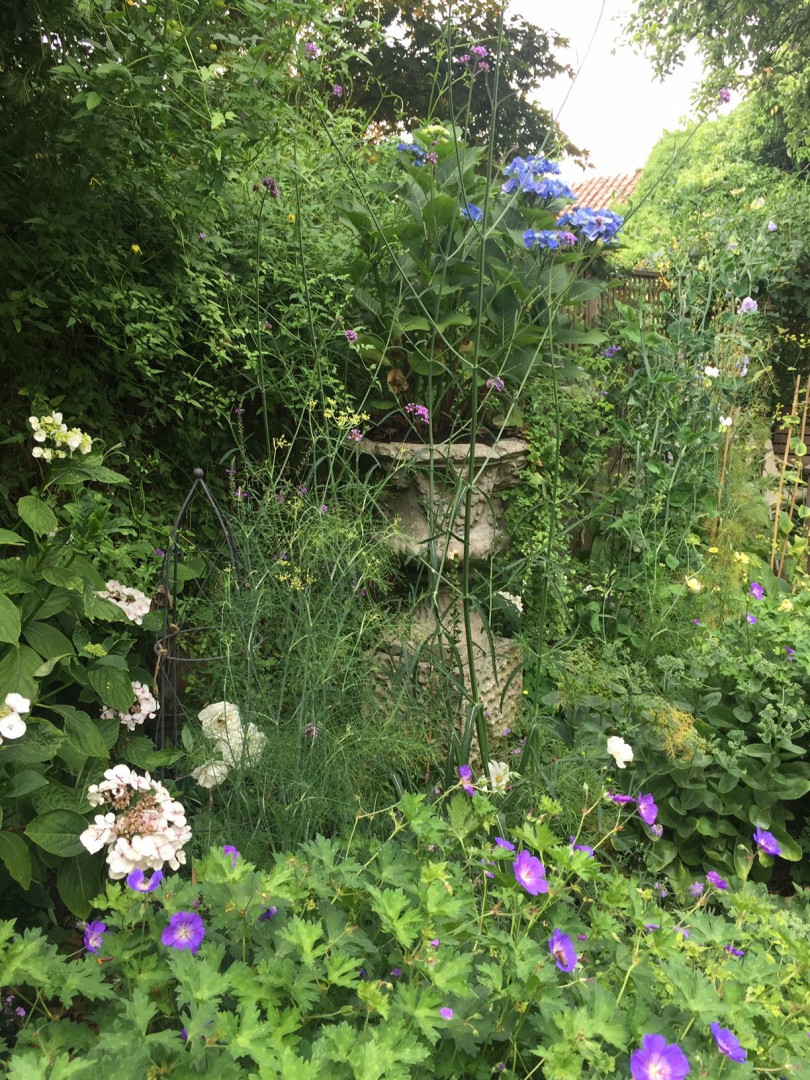
They loved boats and fishing, Peter becoming a keen fisherman as an adult and his brother Derek a world class sailor, returning to the land of his forefathers many times to take part in the Sydney-Hobart race.
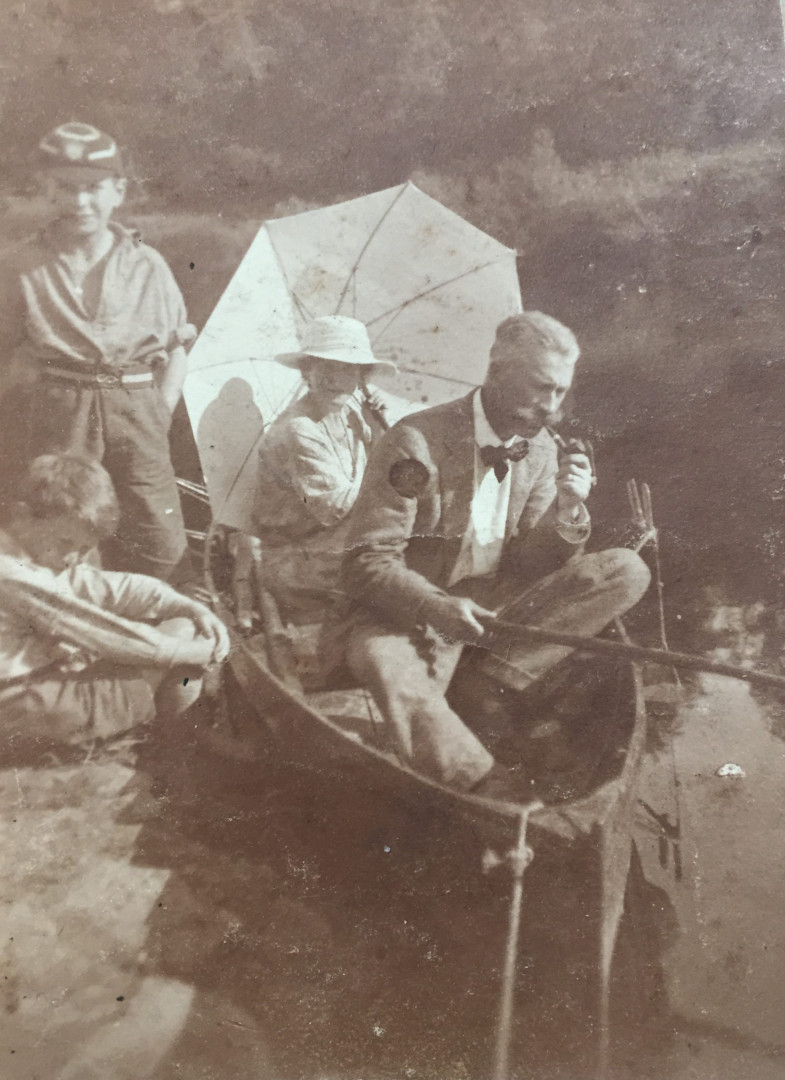
This is Derek, Peter (with cap) and Eva with Ernest wielding rod in one hand and a pipe in the other. We think this is around the time of the Brittany trip when Peter would have sat at the feet of his father, learning his craft. Fifteen years later the boy who drew trains, cars and views of the French countryside was called up as a war artist and sketched planes and pilots. We don’t know what happened to his official work (it included a portrait of General Smuts) but we have a folio of sketches of off-duty airmen listening to concerts, drinking copious amounts of tea or just lounging around enjoying the beautiful landscape in which he always seemed to be posted.
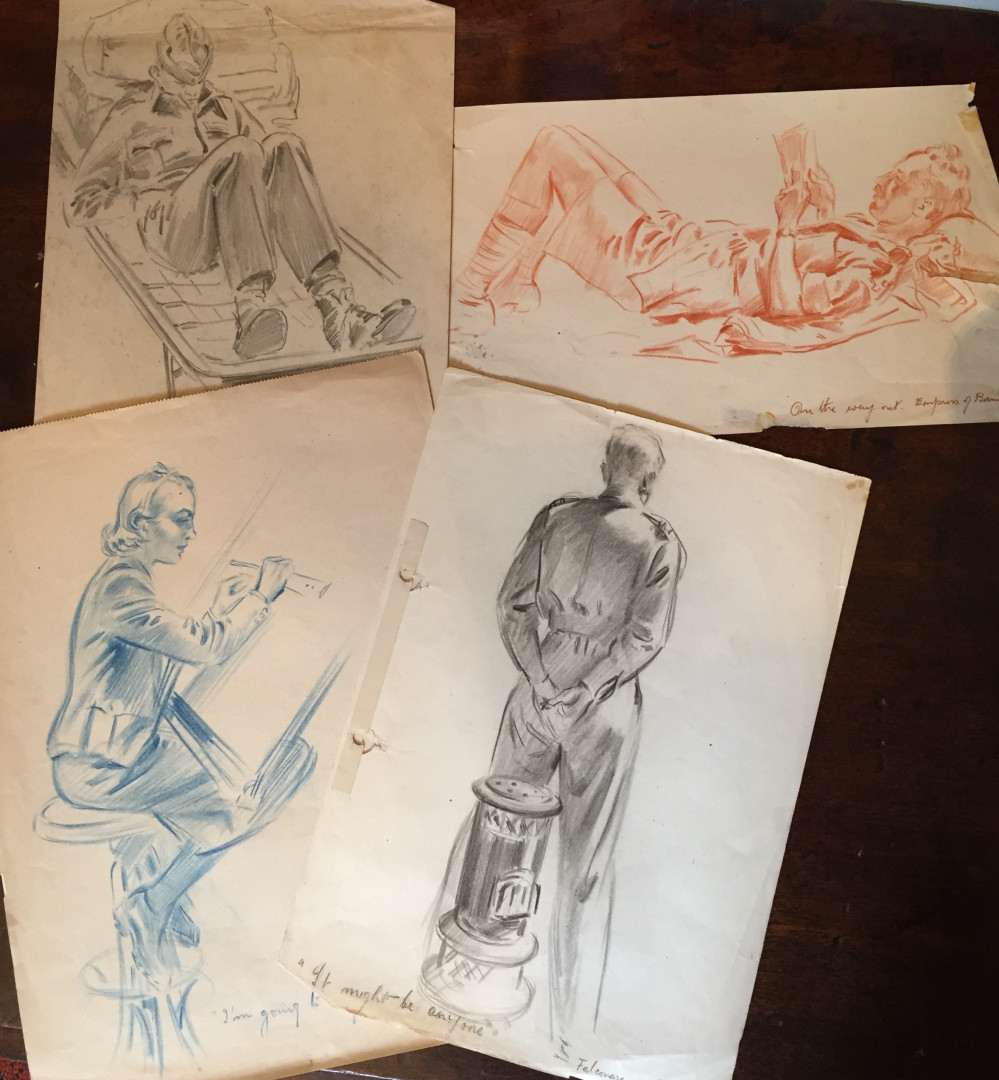
He had a good war, some of it in Cortina with his leg in plaster after a skiing accident, and with time to paint views of Venice and castles on the Austria-Italy border. In the fifties he became a commercial artist (one of the models draped over the bonnet in a Hillman Minx ad is his daughter, now my wife) and finally a portrait painter. We have another folio of photos of his many paintings of judges, company chairmen, their wives, horses and dogs.
His greatest triumph was painting the Queen Mum for the Middle Temple.
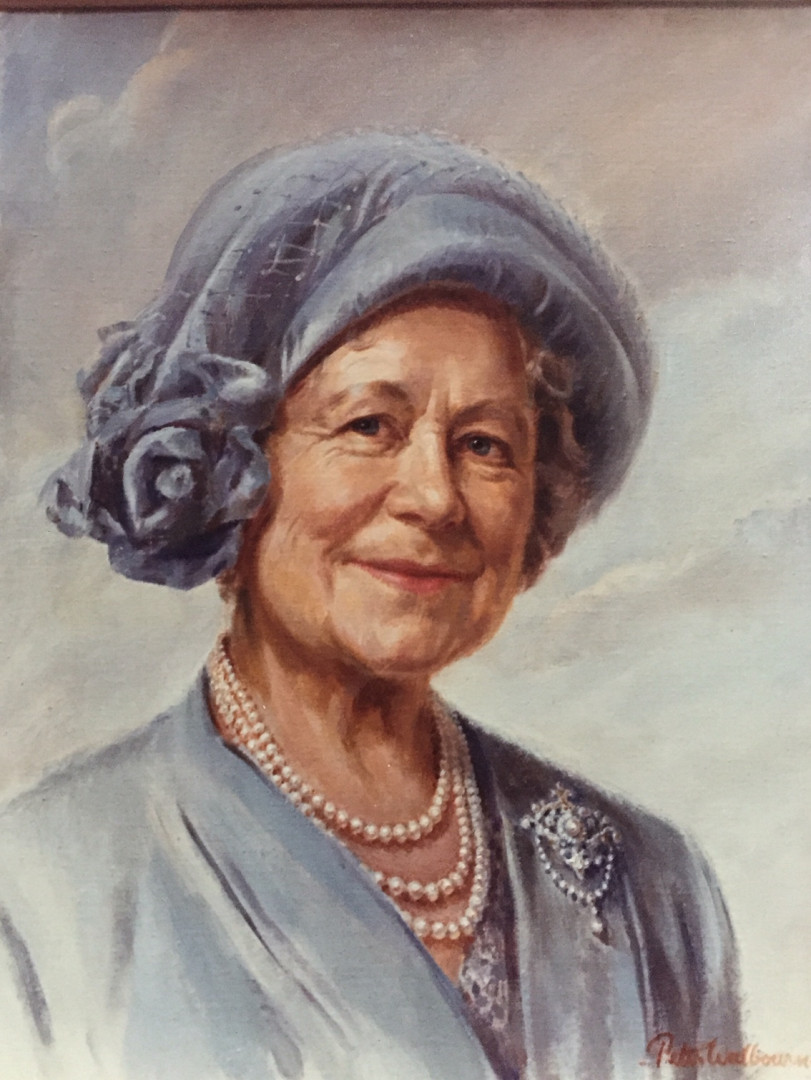
After a sitting he needed more time to get the detail of her jewellery right, so she suggested he take it home. Is it insured, Peter asked, somewhat alarmed. We couldn’t possibly afford to insure it, came her majesty’s reply. Penny’s mum slept with the Queen Mum’s brooch under her pillow to be on the safe side.
The spirits of Ernest and Peter are still with us. Penny’s contemporaries at the Art School in Cambridge included members of the nascent Pink Floyd and we have her sketches of some of the band’s lunchtime jam sessions. This is the young Syd Barrett:
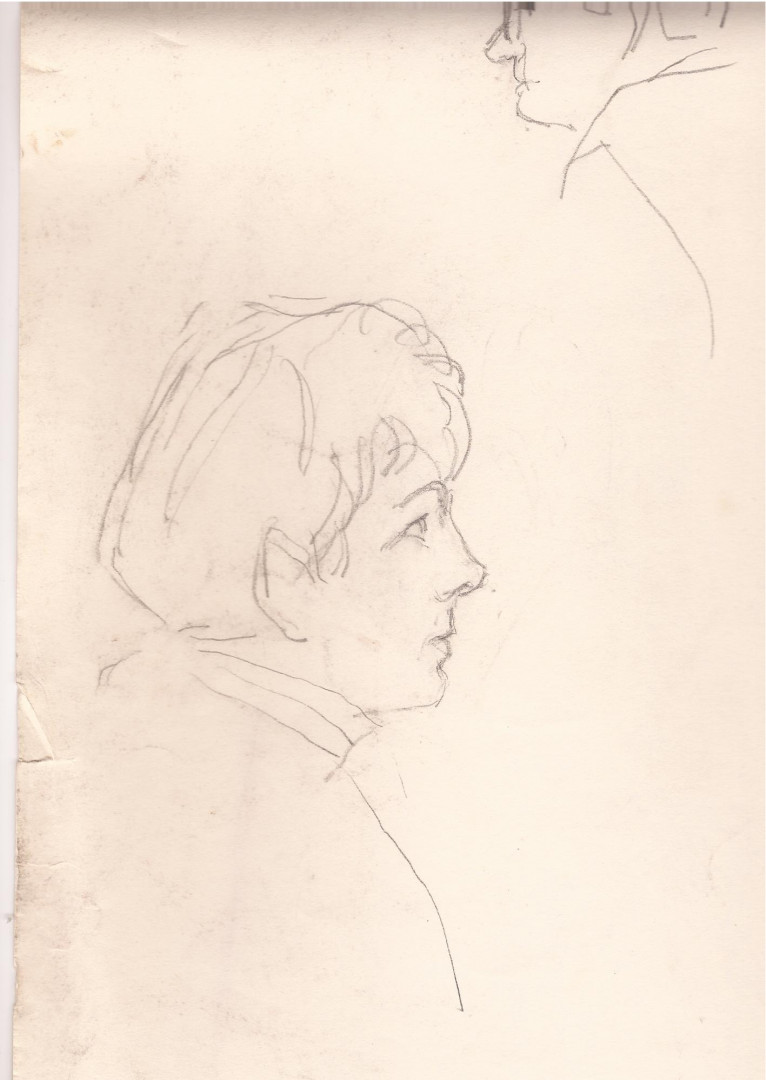
Our son Ned, Peter’s grandson and Ernest’s great grandson, was able to begin a conference in Capetown by cross fading Ernest’s sketch (now on his wall) with a modern photo of the same view.Peter worked at Ernest’s easel all his life, before passing it on to Penny:
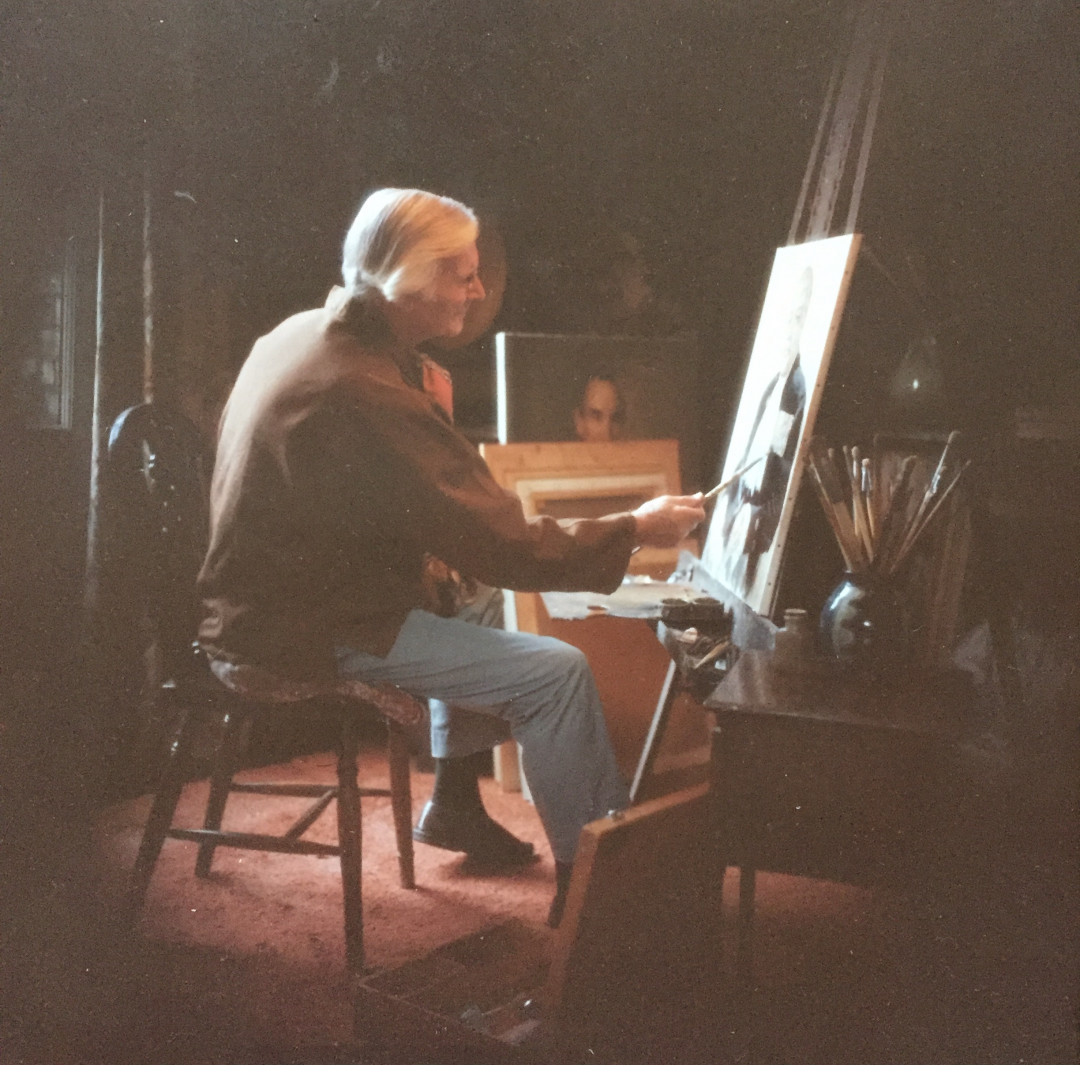
and when we’re not watching tv we can watch an Ernest, still sitting on the easel and awaiting his attention.
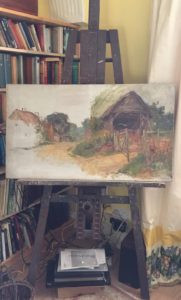
Re-tracing Ernest Walbourn’s 1923 visit to Brittany was hugely exciting but the paintings aren’t really typical of his output, most of which is decidely English. We know from the painting on Ned’s wall that hetook his paints to Australia when he went to sell the family property in 1902 but there don’t appear to be any paintings from down under. Almost all of his subjects are home grown and typical of a certain sort of English art of the time. He may have appreciated Kandinsky, Picasso, Klee or Matisse, but you can’t tell that from his paintings. His landscapes wouldn’t be out of place in a Hardy novel (we also have some sketches from the West country). There are some spectacular (and, nowadays, expensive) paintings of poppy fields. The nearest we have to one of those is a sketch which does have poppies but also a blank space where he never got around to putting in a figure. Even the artist’s art-school educated granddaughter wouldn’t normally attempt the extremely transgressive act of attempting to ‘improve’ an Ernest by painting a new figure, but Penny dared to think we could rescue the sketch by replanting part of the field. This is what it looked like:

The problem is that your eye is drawn immediately to the non-existent figure, rather than seeing what the artist actually saw. It’s a little frightening looking back at what she did…
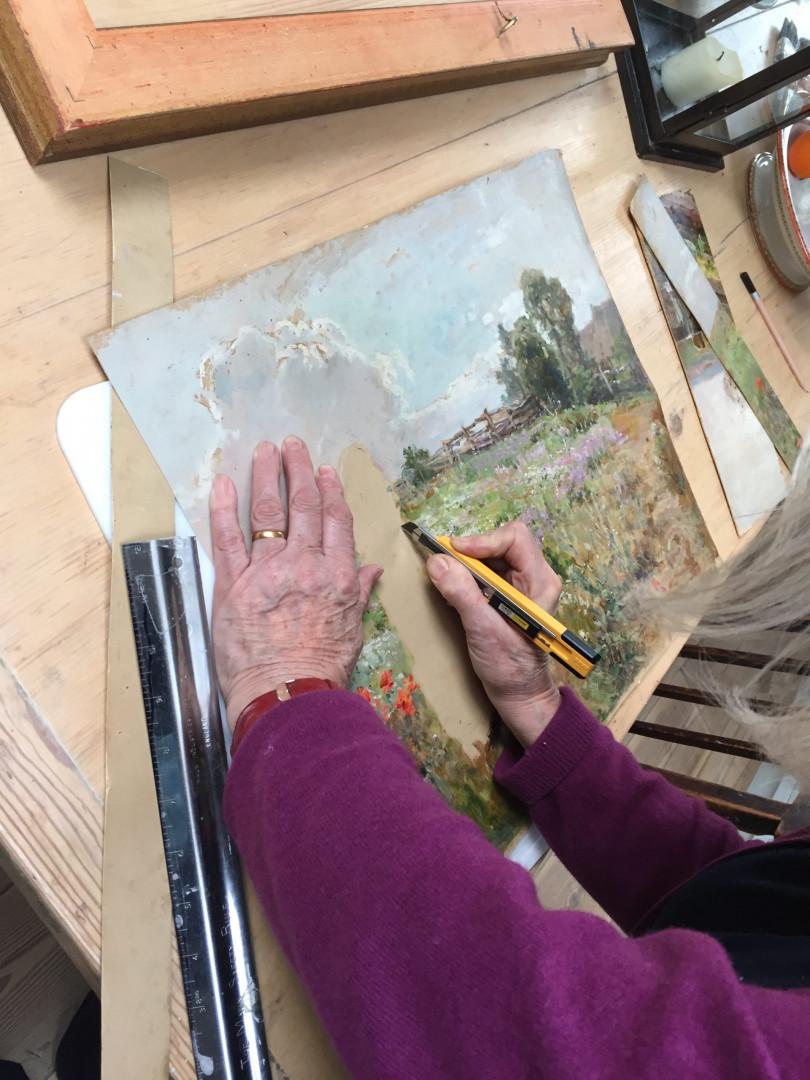
and then this:

Help!
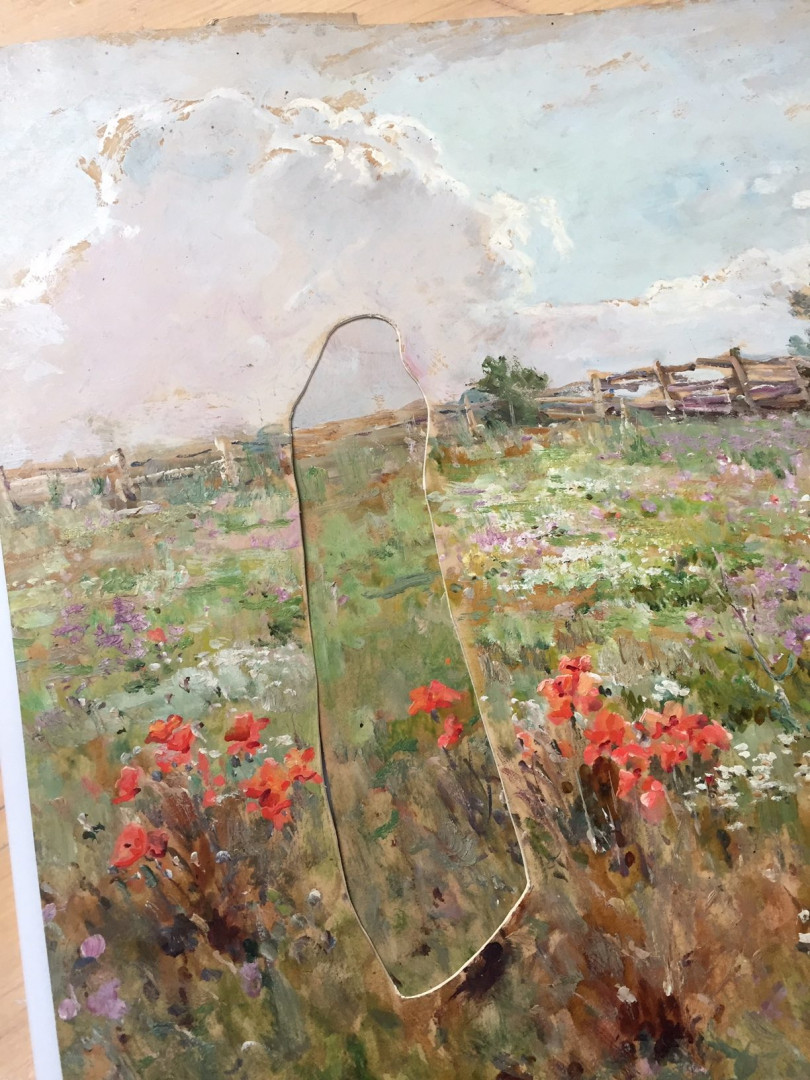
She reduced the width of the original, effectively contracting the view but not otherwise damaging it, and used the offcut to make an insert matched to the shape of the hole. Surely this can’t possibly work…? Well, after a bit of touching up, it did:
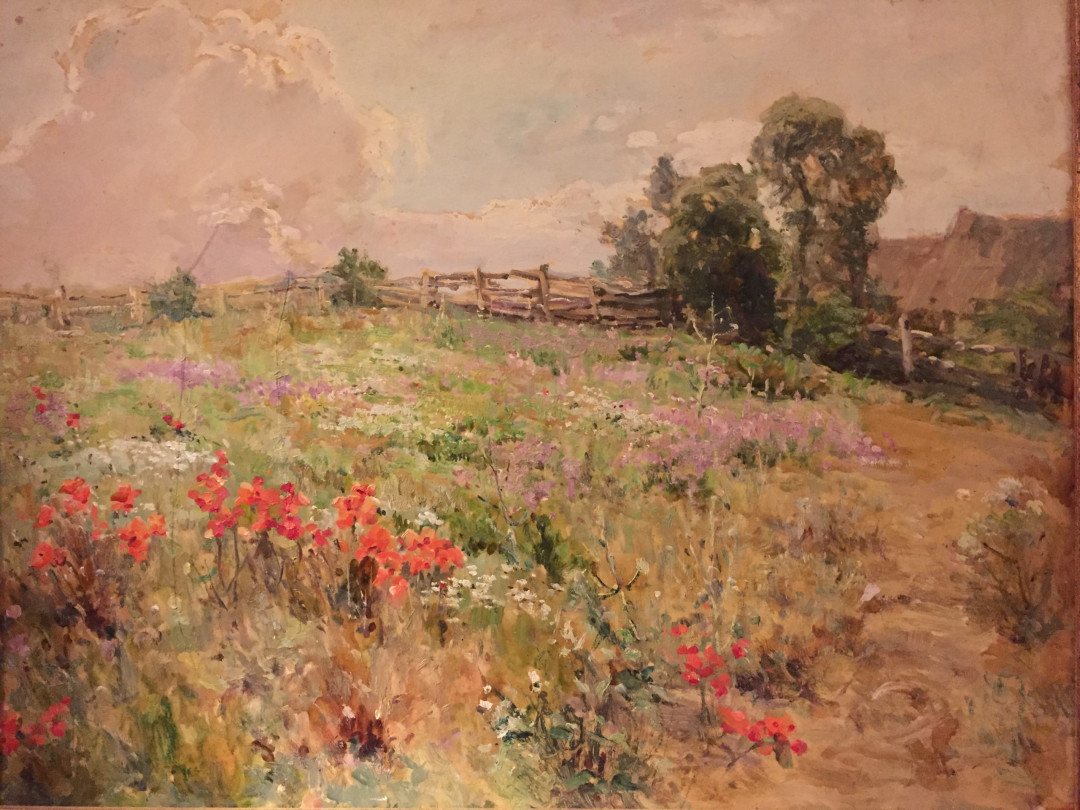
Picture credits: Le Jour des Pauvres by Germaine David-Nillet: Henri Moreau (Wikimedia Commons)
All others John & Penny Potter.